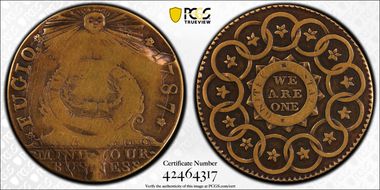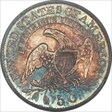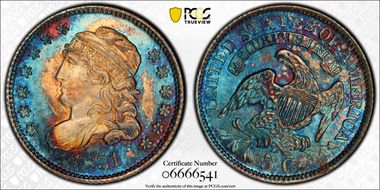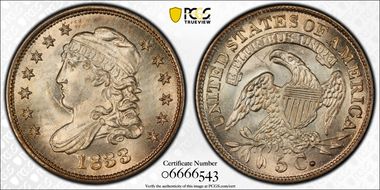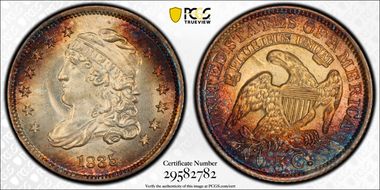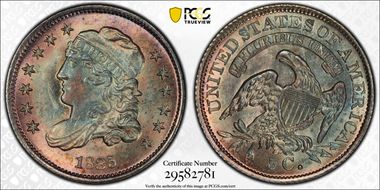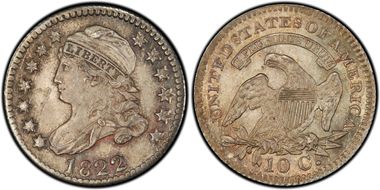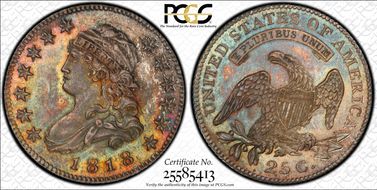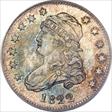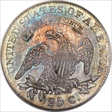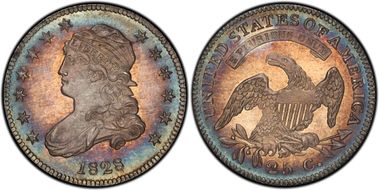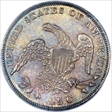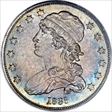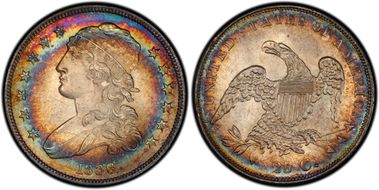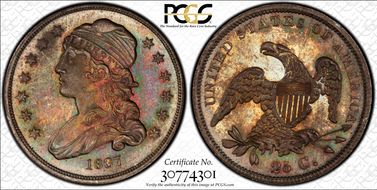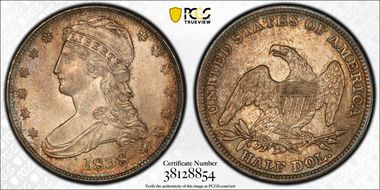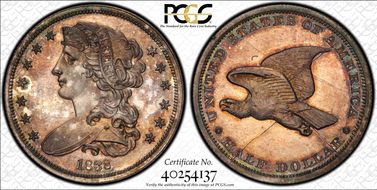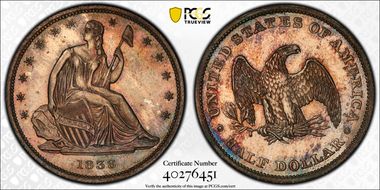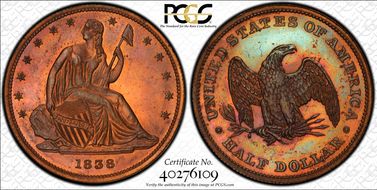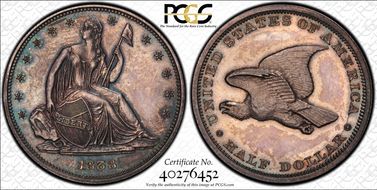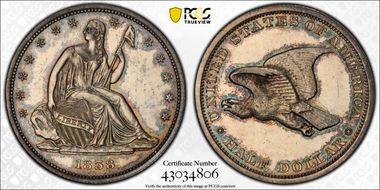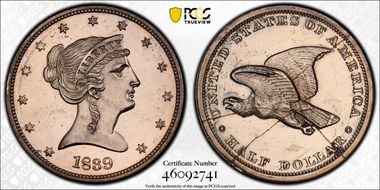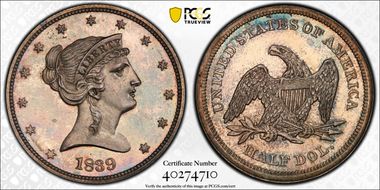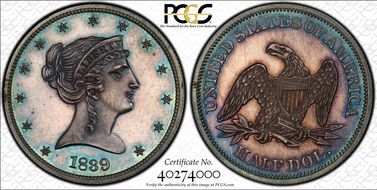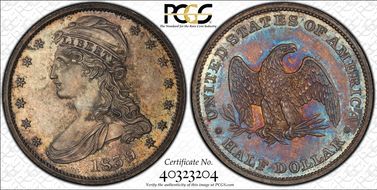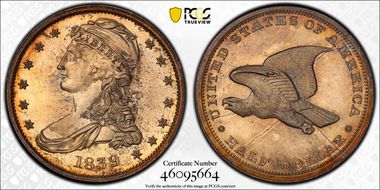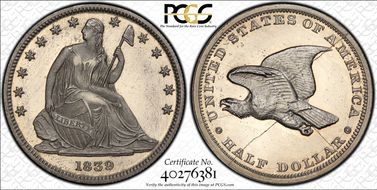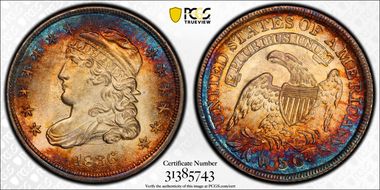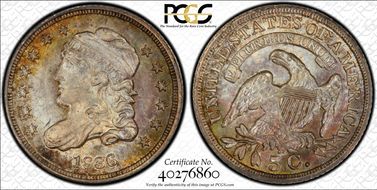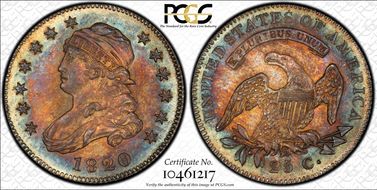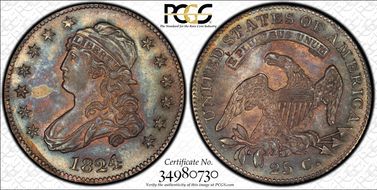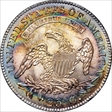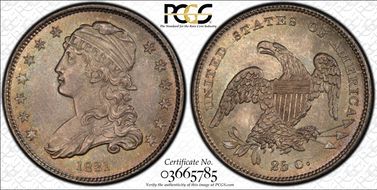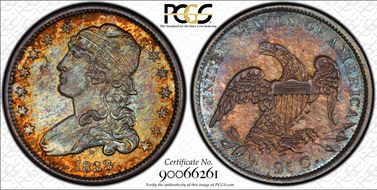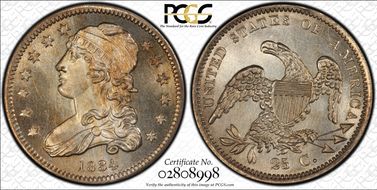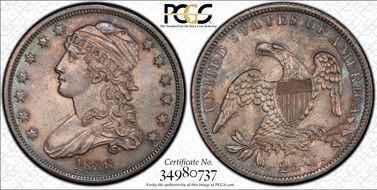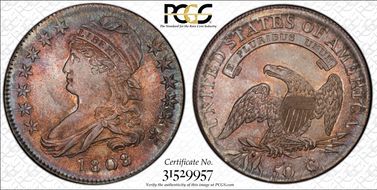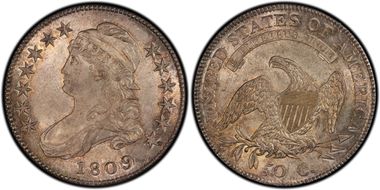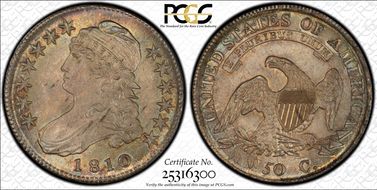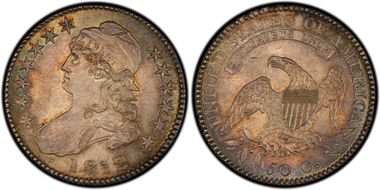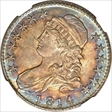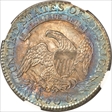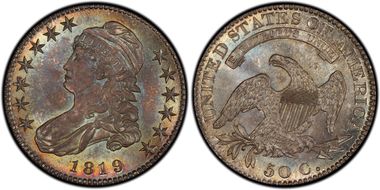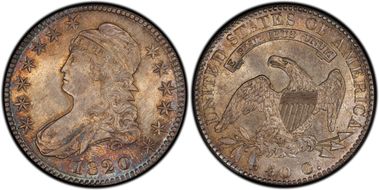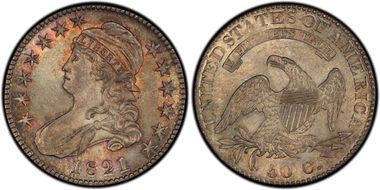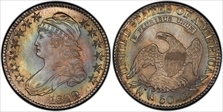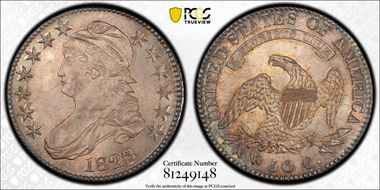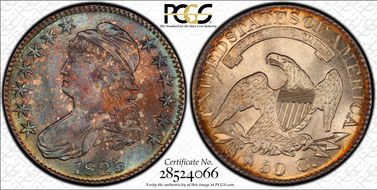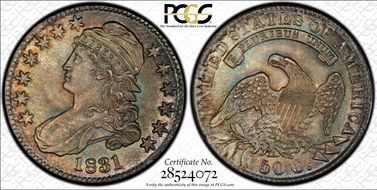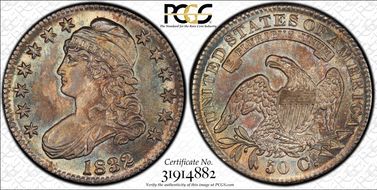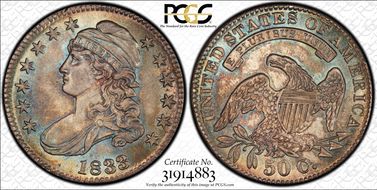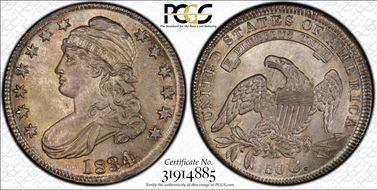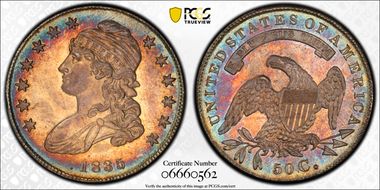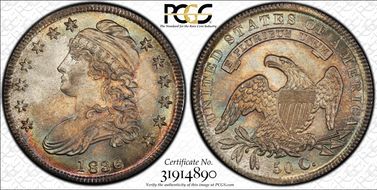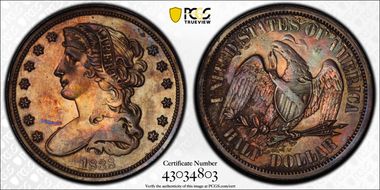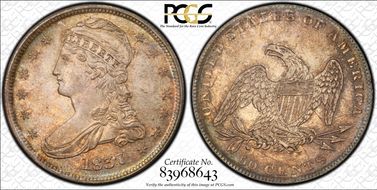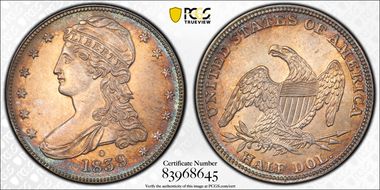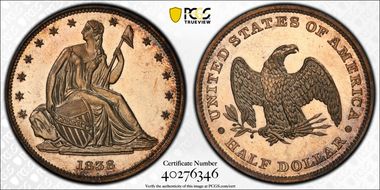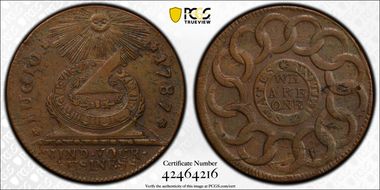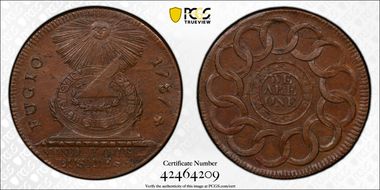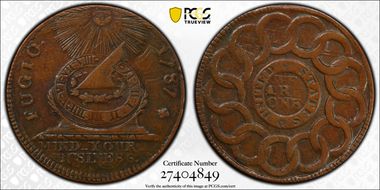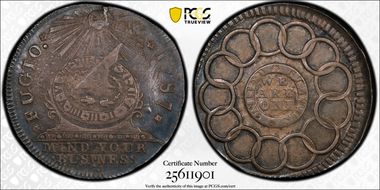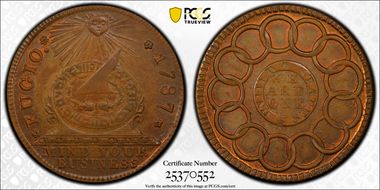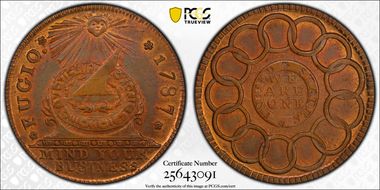[email protected] 的钱币相册
4-E R3. "148.9 grains. Attractive dark chocolate brown with excellent detail for this variety. Some dark verdigris is built up around obverse legends and the reverse peripheries, but it does not seriously impact the eye appeal. Rim flawed above final 7 of date, light striations mostly reserved to right obverse field and right side of reverse. A few short old scratches are present in the left obverse field. Early die state with no crumbling inside the 8. From the Robert Ayers Collection. Earlier from Rosa Americana, Ltd. in March 1985. Paper envelope with attribution notation included," per Stacks Bowers cataloger. Obtained from Stacks Bowers Auction of the Robert Ayers Collection on August 14, 2013, Lot 1338.
4-E R3. "148.9 grains. Attractive dark chocolate brown with excellent detail for this variety. Some dark verdigris is built up around obverse legends and the reverse peripheries, but it does not seriously impact the eye appeal. Rim flawed above final 7 of date, light striations mostly reserved to right obverse field and right side of reverse. A few short old scratches are present in the left obverse field. Early die state with no crumbling inside the 8. From the Robert Ayers Collection. Earlier from Rosa Americana, Ltd. in March 1985. Paper envelope with attribution notation included," per Stacks Bowers cataloger. Obtained from Stacks Bowers Auction of the Robert Ayers Collection on August 14, 2013, Lot 1338.
Newman 103-EE. R8+. Norweb. Unique in Gold. Fugio Cent Restrike. Per cataloger, "New Haven Restrike, Stars in Rings, Gold, VF20 NGC. N. 103-EE, Breen-1345, W-17530, Unique. 13.59 gm. Entrepreneur Horatio N. Rust was the man behind the misnamed New Haven Restrike Fugio cents. Circa 1860, he contracted with the Waterbury, Connecticut, firm Scoville Manufacturing Company to produce several varieties from copy dies. Today, the Plain Rings variety (Newman 104-FF) is relatively plentiful in copper and brass, but the American Congress and Stars in Rings marriages (and their various trials) are formidable rarities. No genuine Fugio cents have stars within the rings, which makes it unclear why Rust designed the EE die with 13 reverse stars. He might have believed the variety could be marketed to collectors familiar with 13 stars on one side (and, sometimes, both sides) of early Federal coins. In any event, not many were made. Two or three pieces are known in silver, including the Col. Green - Eric Newman piece we offered as lot 3076 in our November 2014 Newman Part V Signature. One is known in brass, and Breen lists a copper example but adds it is untraced. The gold example is unique, and was likely the final piece struck from the Newman 103-EE die pair, given the central failure of the obverse die. The obverse border also exhibits a network of fine die cracks. Presumably, the obverse die was not hardened prior to use. The high points are honey-gold, while the fields are tan-brown. No marks are noticeable, but the high-point wear evident on both sides indicates it must have been carried as a pocket piece. The wear may have been an attempt by Rust or an early owner to increase its acceptance as authentic by the 19th-century numismatic community. The present example appeared as lot 661 in the New York Coin & Stamp Co. auction of the celebrated Lorin G. Parmelee collection, and was described as having "no duplicate known in either type or metal." Parmelee sold it to Virgil M. Brand in 1899. Listed on page 90 of the 2021 Guide Book. Ex: Lorin G. Parmelee (New York Coin & Stamp Co., 6/1890), lot 661, where it was bought in; Lorin G. Parmelee (7/31/1899); Virgil M. Brand (Journal #20690); Brand Estate; later, Jon Hanson; Donald G. Partrick." Obtained from Heritage Auction of Donald Partrick Collection on April 22, 2021, Lot 3039.
N-10 R.7. Obtained from Heritage Galleries Auction on January 9, 2020, Lot 4097. Per cataloger, "Ex: Frothingham-Wilson-Pittman Example. N-10, R.7 as a Proof. The manufacture of master coins, as they were known prior to the use of our current word "proof," was spotty at best prior to 1858. Curiously, there was some special need for proof cents in 1822, as at least nine pieces are known of this particular variety and several others are known of other varieties. In the Pittman Sale in 1997, Denis Loring contributed a brief roster of nine examples of proof N-10 cents. The pedigree of this particular coin is long and impressive, stretching back to 1883. The coin was described in this coin's first appearance in the Frothingham Sale as, "Fine proof of brilliant steel color. Very rare." This coin has a couple of distinctive pedigree identifiers: On the obverse a small planchet flake appears in the left field between star 2 and Liberty's chin. On the reverse a couple of lint marks occur around the left side of the N in ONE; another shallow planchet flake is seen above that same letter. Otherwise, the surfaces are deep brown with olive accents. The strike is unusually complete on Liberty's hair. The peripheral stars show just the slightest softness over the highest points. The fields are reflective as expected -- surprisingly so, given the depth of patina present over each side. A raised line surrounds the inner denticles on the obverse, undoubtedly a scribe line used to locate the placement of the denticles. As one can see from the pedigree below, this coin has always brought a high price when offered at public auction. However much it brings in this offering, one thing is certain, it will be impressively high. Our EAC grade PR55. Ex: Charles F. Frothingham Collection (H. G. Sampson, 5/1883), lot 100; James B. Wilson, Esq. Collection (Thomas Elder, 10/1908), lot 1057; Dr. George P. French (FPL, B. Max Mehl), lot 439; New Netherlands 54th Sale (4/1960), lot 1535; John Jay Pittman Collection (Akers, 10/1997), lot 205; Keusch, Snow, & Del Zorro Collections (Stack's, 11/2008), lot 3075; Greensboro Collection, Part II (Heritage, 1/2013), lot 5524. From the Joseph D. Osborne Collection."
N-10 R.7. Obtained from Heritage Galleries Auction on January 9, 2020, Lot 4097. Per cataloger, "Ex: Frothingham-Wilson-Pittman Example. N-10, R.7 as a Proof. The manufacture of master coins, as they were known prior to the use of our current word "proof," was spotty at best prior to 1858. Curiously, there was some special need for proof cents in 1822, as at least nine pieces are known of this particular variety and several others are known of other varieties. In the Pittman Sale in 1997, Denis Loring contributed a brief roster of nine examples of proof N-10 cents. The pedigree of this particular coin is long and impressive, stretching back to 1883. The coin was described in this coin's first appearance in the Frothingham Sale as, "Fine proof of brilliant steel color. Very rare." This coin has a couple of distinctive pedigree identifiers: On the obverse a small planchet flake appears in the left field between star 2 and Liberty's chin. On the reverse a couple of lint marks occur around the left side of the N in ONE; another shallow planchet flake is seen above that same letter. Otherwise, the surfaces are deep brown with olive accents. The strike is unusually complete on Liberty's hair. The peripheral stars show just the slightest softness over the highest points. The fields are reflective as expected -- surprisingly so, given the depth of patina present over each side. A raised line surrounds the inner denticles on the obverse, undoubtedly a scribe line used to locate the placement of the denticles. As one can see from the pedigree below, this coin has always brought a high price when offered at public auction. However much it brings in this offering, one thing is certain, it will be impressively high. Our EAC grade PR55. Ex: Charles F. Frothingham Collection (H. G. Sampson, 5/1883), lot 100; James B. Wilson, Esq. Collection (Thomas Elder, 10/1908), lot 1057; Dr. George P. French (FPL, B. Max Mehl), lot 439; New Netherlands 54th Sale (4/1960), lot 1535; John Jay Pittman Collection (Akers, 10/1997), lot 205; Keusch, Snow, & Del Zorro Collections (Stack's, 11/2008), lot 3075; Greensboro Collection, Part II (Heritage, 1/2013), lot 5524. From the Joseph D. Osborne Collection."
N-1 R7+. Naftzger. One of two known N-1 Proof Large Cents. Tied for finest known at PCGS. Obtained in trade arranged by Chr1s McCawley on September 29, 2021.
LM-12 R4. Lovely colorful, blazing luster, nice strike. Obtained from the heritage Auction #1214 of the Eugene Gardener Collection on 10/27/2014, Lot 98174.
LM-12 R4. Lovely colorful, blazing luster, nice strike. Obtained from the heritage Auction #1214 of the Eugene Gardener Collection on 10/27/2014, Lot 98174.
LM-7 R2. Simpson. Bender. Finest Known 1831 Capped Bust Half Dime. Visually stunning kaleidoscope of color on near perfection in an early half dime. Obtained from Heritage Auction of Bender Family Collection, Part I on August 24, 2022.
LM-13 R.3. CAC. Simpson. Bender. Finest Known Capped Bust Half Dime. Stunning quality, surfaces and eye appeal. Lovely colors with almost unbelievably clean surfaces. A beauty to behold. WOW! Obtained from Heritage Galleries Auction of the Bender Family Collection on August 24, 2022, Lot 3728.
LM-3.4. R.2. CAC. Bender. Simpson. Tied finest known 1833 Capped Half Dime. Extensively clashing and cracking with superb gem surfaces. Pale golden color with superb luster. Obtained from Heritage Auction of Bender Family Collection on August 24, 2022, Lot 3729.
LM-2 R.1. CAC. Bender. Simpson. Tied Finest Known 1834 Capped Half Dime. Red, gold and navy toning with booming luster. Great eye appeal. Obtained from Heritage Auction of Bender Family Collection, Part 1 on August 24, 2022, Lot 3730.
LM-8.2 R.2. CAC. Bender. Simpson. Finest Known 1835 Small Date, large 5C Capped Bust Dime. Golden toning with luster and originality. Obtained from Heritage Auction of the Bender Family Collection on August 24, 2022, Lot 3733.
LM-10 R.1 CAC. Finest 1835 Small Date, Small 5C. Lovely rose and purplish toning emanating from flashy cartwheel luster. Heritage Auction of Tom Bender Family Collection, Part 1 on August 24, 2022, Lot 3734.
LM-? CAC. Finest Known 1837 Large 5C Capped Bust Half Dime. Obtained by private treaty from Matt Kleinstuber on August 17, 2022.
LM-4 R3. Light tan peripheral toning. Obtained by private treaty with David Sunshine on December 1, 2019.
JR-1 R4. CAC. Wonderful original surfaces. Second finest known at PCGS behind a single MS66 at PCGS.
B-1 R.1. CAC. Tied Finest Known. "Several die states are known for the 1815 quarter, this piece being a later die state with very light clashing on each side but most notable on the reverse. Beautifully toned in shades of mauve, orange-gold, light purple and hints of green with exceptional luster and truly lovely overall eye appeal. PCGS has certified just 3 at this level with nothing graded finer and this is the only coin verified at this level by CAC. From The Clarendon Collection," per Mike Printz. "The December delivery was sent upon request of the Planter's Bank, who apparently needed the coins as a replacement for Mexican two reales coins of a similar value. An exchange of letters took place between Bailly Blanchard, cashier of the Planter's Bank, and Mint Director Robert L. Patterson. Blanchard insisted that the bank could only use quarter dollars, while Patterson wanted to send the entire amount in dimes. More than six months elapsed from the first letter requesting the coins and the date they were delivered. Several die states are known for the 1815 quarter, and this piece is a later die state with light clash marks on each side, especially visible on the reverse. It is probably one of the later January 10 coins. It is also a lovely Condition Census candidate with full silver luster beneath heavy iridescent toning, deepening to steel along the borders. Population: 3 in 66, 0 finer (11/09)," per heritage cataloger. Obtained by private treaty with Michael Printz at Harlan J Berk, Ltd. on 7/14/2013. Prior Heritage Auction 31136 on January 7, 2010, Lot 2503.
B-1 R.1. CAC. Tied Finest Known. "Several die states are known for the 1815 quarter, this piece being a later die state with very light clashing on each side but most notable on the reverse. Beautifully toned in shades of mauve, orange-gold, light purple and hints of green with exceptional luster and truly lovely overall eye appeal. PCGS has certified just 3 at this level with nothing graded finer and this is the only coin verified at this level by CAC. From The Clarendon Collection," per Mike Printz. "The December delivery was sent upon request of the Planter's Bank, who apparently needed the coins as a replacement for Mexican two reales coins of a similar value. An exchange of letters took place between Bailly Blanchard, cashier of the Planter's Bank, and Mint Director Robert L. Patterson. Blanchard insisted that the bank could only use quarter dollars, while Patterson wanted to send the entire amount in dimes. More than six months elapsed from the first letter requesting the coins and the date they were delivered. Several die states are known for the 1815 quarter, and this piece is a later die state with light clash marks on each side, especially visible on the reverse. It is probably one of the later January 10 coins. It is also a lovely Condition Census candidate with full silver luster beneath heavy iridescent toning, deepening to steel along the borders. Population: 3 in 66, 0 finer (11/09)," per heritage cataloger. Obtained by private treaty with Michael Printz at Harlan J Berk, Ltd. on 7/14/2013. Prior Heritage Auction 31136 on January 7, 2010, Lot 2503.
B-2 R1. CAC. Shield Holder. "Popular B-2 Variety, Only One Finer Coin at PCGS. No quarters were struck in 1816 and 1817, but a substantial mintage of 361,174 pieces was produced in 1818. Five obverse and seven reverse dies were combined to produce 10 known die varieties for the date. This coin represents the B-2 variety, with star 13 repunched and the scroll starting under the center of the upright of D in UNITED. The B-2 is the most available variety of the date. The present coin is a spectacular Premium Gem with iridescent shades of greenish-gold toning that fades to blue and violet. The design elements are sharply detailed and the well-preserved surfaces display vibrant mint luster under the toning. Population: 4 in 66, 1 finer ," per Heritage cataloger. Obtained from Heritage Galleries Auction #1192 on December 5, 2013, Lot 3587.
B-1 R2. Finest Known by 3 grading points. Only 4 large Sized Capped Quarters are graded MS67 at PCGS (and none finer) Per cataloger,"Single-Finest Certified. Recently Rediscovered Example. B-1, R.2, MS67 PCGS. A small mintage of 64,080 Capped Bust quarters was accomplished in 1822, with just two die varieties known for the date. This coin represents the more available B-1 variety, easily recognized by the Square Base 2 in the denomination. The scarce B-2 variety displays a blundered 25/5/50 denomination, and employs a Curl Base 2 numeral punch. A single obverse die was used to strike the entire production run and all coins seen were struck from perfect dies. The Capped Bust quarters were first studied and attributed by die varieties in the 1870s, by Captain John W. Haseltine and John Colvin Randall. In his famous Type Table catalog from November 1881, Haseltine described the 1822 B-1 quarter in lot 1330 as: "1822; No. 1; upper left star points to the junction of the upper curl with the band on the forehead; rev., P and I in 'Pluribus' are slightly to the left of being under the centres of S and second T in 'States' very fine; scarce." The lot realized $3.40, a strong price for the time. More recent sales include the spectacular MS64 NGC example from the "Colonel" Green-Eric P. Newman Collections (Heritage, 11/2013), lot 33168, which realized $25,850. That coin was billed as the finest known business-strike 1822 B-1 quarter at the time, but this piece easily eclipses it. The present coin has been off-the-market for decades and is not included in any recent Condition Census. It is the single-finest certified example at either of the leading grading services, with no serious challenger. We believe it is the Anderson Dupont example, last sold in lot 1796 of that Stack's sale in November of 1954, but the low-quality of the image in that appearance makes plate matching problematic. Like most examples seen, this coin shows just a touch of softness on some stars and the eagle's claw, but the eagle's feathers and Liberty's hair and drapery are boldly rendered. The impeccably preserved surfaces radiate vibrant mint luster, under spectacular shades of gold, lavender, and silver-gray toning. Eye appeal is terrific. This coin is a Registry Set essential. Population: 1 in 67, 0 finer (4/15)." Obained from Heritage Long Beach Auction #1221 on June 4, 2015, Lot 3896.
B-1 R2. Finest Known by 3 grading points. Only 4 large Sized Capped Quarters are graded MS67 at PCGS (and none finer) Per cataloger,"Single-Finest Certified. Recently Rediscovered Example. B-1, R.2, MS67 PCGS. A small mintage of 64,080 Capped Bust quarters was accomplished in 1822, with just two die varieties known for the date. This coin represents the more available B-1 variety, easily recognized by the Square Base 2 in the denomination. The scarce B-2 variety displays a blundered 25/5/50 denomination, and employs a Curl Base 2 numeral punch. A single obverse die was used to strike the entire production run and all coins seen were struck from perfect dies. The Capped Bust quarters were first studied and attributed by die varieties in the 1870s, by Captain John W. Haseltine and John Colvin Randall. In his famous Type Table catalog from November 1881, Haseltine described the 1822 B-1 quarter in lot 1330 as: "1822; No. 1; upper left star points to the junction of the upper curl with the band on the forehead; rev., P and I in 'Pluribus' are slightly to the left of being under the centres of S and second T in 'States' very fine; scarce." The lot realized $3.40, a strong price for the time. More recent sales include the spectacular MS64 NGC example from the "Colonel" Green-Eric P. Newman Collections (Heritage, 11/2013), lot 33168, which realized $25,850. That coin was billed as the finest known business-strike 1822 B-1 quarter at the time, but this piece easily eclipses it. The present coin has been off-the-market for decades and is not included in any recent Condition Census. It is the single-finest certified example at either of the leading grading services, with no serious challenger. We believe it is the Anderson Dupont example, last sold in lot 1796 of that Stack's sale in November of 1954, but the low-quality of the image in that appearance makes plate matching problematic. Like most examples seen, this coin shows just a touch of softness on some stars and the eagle's claw, but the eagle's feathers and Liberty's hair and drapery are boldly rendered. The impeccably preserved surfaces radiate vibrant mint luster, under spectacular shades of gold, lavender, and silver-gray toning. Eye appeal is terrific. This coin is a Registry Set essential. Population: 1 in 67, 0 finer (4/15)." Obained from Heritage Long Beach Auction #1221 on June 4, 2015, Lot 3896.
B-4 R3. CAC. Per cataloger, ""Incredible Gem 1828 Bust Quarter. Boldly Prooflike. Finest Graded by PCGS. 1828 Capped Bust Quarter. B-4. Rarity-3. MS-66+ (PCGS). CAC. The portrait of Miss Liberty is boldly rendered and displays delicate violet-gold iridescence. The surrounding reflective fields display amber and indigo iridescence radiating out toward the peripheries. The reflectivity is even more pronounced on the reverse, where the field contrasts markedly with a fully impressed, razor sharp eagle. Vibrant tangerine tones at the center of the reverse cool to teal at the borders. Virtually pristine and thoroughly appealing. This coin ranks as the single finest 1828 quarter of any die variety known to PCGS. We had the pleasure of offering this coin in our (Bowers and Ruddy) February 1976 Dr. D.C. Montgomery, Jr. Collection sale. As that time we described this piece as: ""1828 quarter dollar. Perfect reverse die. Purchased as a superb Proof, this coin possesses 99% of the characteristics of a later (i.e., Liberty seated) Proof, including prooflike surface within the shield stripes. It was undoubtedly struck as a presentation piece, so perfect are its fields and so sharp is its strike. ""If an equal or finer 1828 quarter dollar exists, we haven't seen it. Actually, it is doubtful if a finer one could exist, even in theory. A superb coin for the connoisseur!"" In the numismatic market of the 21st century, the science of positively identifying early (read: pre-1858) United States Mint Proof and specimen coins has become more exact, and PCGS has determined the present example to be a circulation strike. Proofs are known from the 1828 B-4 quarter dies, however, with the online version of the PCGS Population Report accounting for six to eight examples. That estimate squares nicely with the census of seven Proofs listed in the 2010 book Early Quarter Dollars of the United States Mint: 1796-1838 by Rory R. Rea, et al. The existence of Proofs for this variety, coupled with the exceptional strike and prooflike finish of this coin, suggest that it was one of the very first circulation strikes produced after these dies were used to strike one or more of the Proofs. However PCGS is in full concurrence with our earlier (and also current) assessment of this coin as they have confirmed it as the finest 1828 quarter ever to pass through their hands. One of the leading highlights in the Kaselitz Collection -- which is saying quite a lot given the multitude of significant offerings herein. This Gem is sure to see spirited bidding among leading numismatists. Pedigree: Ex our (Bowers and Ruddy's) Dr. D.C. Montgomery, Jr. Collection sale, February 1976, lot 1271.PCGS Population (all die varieties of the issue): just 1; 0 finer." Obtained from Stacks Bowers Auction of the Douglas Kaselitz Collection on July 17, 2015, Lot 5142.
B-5 R.2. CAC. Gardner. Tied second finest at PCGS. Per cataloger, "Condition census for the date and variety. This stellar Gem B-5 1835 quarter is toned medium-gray in the centers while combining blue peripheral accents and hints of rose-gold in the fields. The surface quality is outstanding, as expected for the grade. This piece is identifiable by a pair of minute nicks in the field before Liberty's chin and another tick on the neck. The strike is sharp on all of Liberty's curls and each star save for star 7, which lacks the central radial lines." Sold previously in the Heritage Auction #1214 of the Eugene Gardner Collection on October 27, 2014, Lot 98351. Obtained by private treaty with legend Numismatics on October 31, 2014.
B-5 R.2. CAC. Gardner. Tied second finest at PCGS. Per cataloger, "Condition census for the date and variety. This stellar Gem B-5 1835 quarter is toned medium-gray in the centers while combining blue peripheral accents and hints of rose-gold in the fields. The surface quality is outstanding, as expected for the grade. This piece is identifiable by a pair of minute nicks in the field before Liberty's chin and another tick on the neck. The strike is sharp on all of Liberty's curls and each star save for star 7, which lacks the central radial lines." Sold previously in the Heritage Auction #1214 of the Eugene Gardner Collection on October 27, 2014, Lot 98351. Obtained by private treaty with legend Numismatics on October 31, 2014.
B-3 R1. Newman and Green. Finest Certified for the Variety and Year. Per Heritage cataloger, "Ex: "Col." E.H.R. Green. Early Quarter Dollars Plate Coin. Five different die marriages were used in 1836 in striking a reported 472,000 quarters. Four of those die marriages were known to pioneer Bust quarter researcher Ard W. Browning in 1925. The fifth die marriage known, 1836 B-5, was discovered by Robert Spangler in 1988. Ranked High R.6 today, it is by far the rarest variety of the year. The B-2 and B-3 marriages are the most frequently seen for the year, which saw the use of four obverse dies. The obverse of the B-3, used only in this die pairing, shows star 13 about centered between the curl and the dentils. The left edge of the lowest hair curl is over the left side of the 6. The date is punched relatively low, the lowest of any die for the year. Three reverse dies were used in 1836. This reverse die is again solely seen in the B-3 variety. The 25C is low and closer to the dentils than to the eagle; the eagle has a tongue. The arrow feather is over the right half of the 2 in 25C, and the olive stem is over the right half of the C. This Superb Gem with the added NGC Star designation was stuck from an advanced state of the dies on each side, showing a multitude of interesting die cracks designated as Die State d in Early Quarter Dollars of the United States Mint. This piece is the plate coin in that reference. It is the finest certified1836 B-3 quarter, and it is by three grade points the finest certified circulation strike for the date. Concentric multicolored rings encircle Liberty on the obverse of this beautiful, originally toned coin. The reverse is toned an even light to medium gold, with blues and deeper amber-gold at the rims. Ex: "Colonel" E.H.R. Green; Green Estate; Partnership of Eric P. Newman / B.G. Johnson d.b.a. St. Louis Stamp & Coin Co.; Eric P. Newman; Eric P. Newman Numismatic Education Society. Crossed by Jason Carter from NGC 67* to PCGS MS67. Obtained by private treaty from Jason Carter on December 4, 2014.
B-2 R1. CAC. Gardner. Exquisite beauty with color, dazzling luster and great eye appeal. private treaty with Legend Numismatics on October 22, 2014. l
B-4 R7+. Gardner. Reed Hawn. Frank Nichol. Per Heritage cataloger, "B-4, R.8 as a Proof. Vivid shades of gunmetal-gray, steel-blue, and greenish-gold toning enhance the well-preserved fields of this delightful early proof, while hints of frosty brilliance cling to the central devices. The design elements exhibit pinpoint definition in most areas, but a few of the upper stars are flat at the centers and the eagle's right (facing) claw is a little soft. The fields are deeply reflective under the toning, and definite field-device contrast is evident when the coin is tilted in the light. This coin is the second or third finest known example of this rare early proof issue. Two PR67 coins are listed in the population data, one at NGC and one at PCGS, but we suspect those represent the same coin, from the Eliasberg Collection, which was graded PR66 uncertified in its last auction appearance. Our roster below includes five different coins from three different die varieties. Three of the five known proofs represent the B-5 variety. This coin is the only proof example of the B-4 variety that can be traced with any certainty, although another specimen was offered in two auctions many years ago. This coin combines high technical quality, stunning visual appeal, and absolute rarity in one irresistible package. It may be many years before a comparable example becomes available, so advanced collectors should bid accordingly. NGC has graded four proof specimens, one each in PR67, two in PR65, and one PR64. PCGS has graded only one coin, a PR67 example (11/18). These totals may include some resubmissions and crossovers, as we know the Smithsonian coin (see roster below) has not been submitted for certification. PCGS CoinFacts estimates the surviving population at four or five pieces in all grades. Seen by Walter Breen in the 1950s; Reed Hawn; Hawn Collection (Stack's, 3/1977), lot 271; Paramount Rare Coin List 18-19 (1978); Auction '80 (Superior, 8/1980), lot 116; Bernard Turkus Collection (Superior, 6/1981), lot 513; Albert O. Woods Collection (Superior, 9/1986), lot 3434; Auction '90 (Superior, 8/1990), lot 1070; (Superior, 2/1999), lot 698, realized $48,875; Eugene H. Gardner Collection (Heritage, 10/2014), lot 98354. From The Greensboro Collection, Part VII. Heritage FUN Platinum Auction #1291 on January 10, 2019, Lot 4444" Crossed from NGC PR65 [379333-001] to PCGS PR64 on April 29, 2022.
B-2 R.8. CAC. Pogue and Garret. Two examples in private hands and one in the Smithsonian. Provenance: Ex J. Colvin Randall; W. Elliot Woodward's sale of the Numismatic Cabinet of Mr. J. Colvin Randall of Philadelphia, June 1885, lot 570; T. Harrison Garrett Collection, via Harold P. Newlin; T. Harrison Garrett to Robert and John Work Garrett, by descent, 1888; Robert Garrett interest to John Work Garrett, 1919; transfer completed 1921; John Work Garrett to The Johns Hopkins University, by gift, 1942; our (Bowers and Ruddy's) sale of the Garrett Collection for The Johns Hopkins University, Part II, March 1980, lot 636; our (Stack's Bowers Galleries'), in conjunction with Sotheby's, sale of the D. Brent Pogue Collection, Part I, May 2015, lot 1070. Obtained by private treaty arranged by Brian Kendrella with Stacks Bowers on 11/10/2017.
B-1 R.8+. CAC. Unique in Proof format. Ex; Eugene Gardner. One of the all time classic early American silver rarities. The finest known of the enigmatic 1823/2 quarters from a total population of 31. The finest known circulation example is also ex-Gardner and currently graded PCGS AU58+ Gold CAC. Arguably the most important capped Bust Quarter extant. Prior ownership includes many numismatic luminaries including Waldo Newcomer, Jerome Kern, R.L. Miles Jr., Reed Hawn and Dr. Juan Suros. Hard to describe how excited I was when this hammered down, truly one of the most exciting moments that I have had collecting punctuated by shaking hands with Eugene Gardner after the sale. Obtained June 23, 2014 from The Heritage Galleries Auction of the Eugene H. Gardner Collection.
B-2 R.8. CAC. Eliasberg. Pogue. Superb Master coin from the earliest days of the mint. Potentially the finest known large size Capped Bust Quarter. Breathtaking eye appeal, color and near perfect, original surfaces. Obtained by private treaty from Kevin Lipton on August 2, 2018.
B-2 R.8 Pittman. Boyd. Finest 1825 Proof Quarter of 2 Known . Lovely original surfaces with deep and full mirrors. Obtained from Stacks Bowers Auction on August 8, 2022, Lot 7029.
Original B-1 R.7 CAC. Variety, Ex: Boyd. Classic Silver Rarity, Nine Examples Known. This delightful Choice proof exhibits deeply reflective fields, even in the tiny spaces between the shield stripes. The central devices display razor-sharp definition and rich mint frost, but some stars show incomplete radials. The coin is well-centered. Vivid shades of cerulean-blue, champagne-gold, burnt-orange, and sea-green toning enhance the mirrored surfaces. Variety: All Original 1827 quarters were struck from the same pair of dies. The variety was designated as B-1 by Ard W. Browning in his seminal work on the series. The B-1 reverse features a Curl Base 2 in the denomination, while the B-2 Restrikes all display a Square Base 2. The 1827 B-1 obverse die was produced by overdating the 1823/2 B-1 obverse. Population Data (5/14): Only nine Original 1827 quarters are known, but several coins have been resubmitted or crossed over, as evidenced by the single known VF specimen appearing in the data of both services. Provenance: Arthur G. Coffin by December 1867, per a letter from Edward Cogan to Joseph Reakirt; Col. James H. Taylor Collection (William Strobridge, 11/1875), lot 1236; John G. Kellogg Sale (Thomas Elder, 10/1916), lot 1409; Virgil Brand, (Brand Journal number 81228); Armin Brand; F.C.C. Boyd; World's Greatest Collection (Numismatic Gallery, 3/1945), lot 89; Will W. Neil; Neil Collection (B. Max Mehl, 6/1947), lot 897; B. Max Mehl, offered in a full-page ad in the March 1952 The Numismatist, page 289; R.L. Miles; Miles Collection, Part II (Stack's, 4/1969), lot 898; H. Philip Speir; Speir Collection (Stack's, 3/1974), lot 20; ANA Convention Auction (Kagin's, 8/1977), lot 1175; Auction '79 (Stack's, 7/1979), lot 581; Arnold and Romisa Collections (Bowers and Merena, 9/1984), lot 2653; Baltimore Sale (Superior, 7/1993), lot 324; Harold Rothenberger Sale (Superior, 1/1994), lot 1248; May Auction (Superior, 5/1994), lot 576; September Auction (Superior, 9/1998), lot 251. Note: Although this coin was offered in the Col. James Taylor Collection catalog by William Strobridge in 1875, it was not part of Taylor's consignment. The actual consignor is unknown. Obtained from "The Eugene H. Gardner Collection of US Coins" Heritage Signature Auction - New York #1213 on June 23, 2014, Lot 30357.
Original B-1 R.7 CAC. Variety, Ex: Boyd. Classic Silver Rarity, Nine Examples Known. This delightful Choice proof exhibits deeply reflective fields, even in the tiny spaces between the shield stripes. The central devices display razor-sharp definition and rich mint frost, but some stars show incomplete radials. The coin is well-centered. Vivid shades of cerulean-blue, champagne-gold, burnt-orange, and sea-green toning enhance the mirrored surfaces. Variety: All Original 1827 quarters were struck from the same pair of dies. The variety was designated as B-1 by Ard W. Browning in his seminal work on the series. The B-1 reverse features a Curl Base 2 in the denomination, while the B-2 Restrikes all display a Square Base 2. The 1827 B-1 obverse die was produced by overdating the 1823/2 B-1 obverse. Population Data (5/14): Only nine Original 1827 quarters are known, but several coins have been resubmitted or crossed over, as evidenced by the single known VF specimen appearing in the data of both services. Provenance: Arthur G. Coffin by December 1867, per a letter from Edward Cogan to Joseph Reakirt; Col. James H. Taylor Collection (William Strobridge, 11/1875), lot 1236; John G. Kellogg Sale (Thomas Elder, 10/1916), lot 1409; Virgil Brand, (Brand Journal number 81228); Armin Brand; F.C.C. Boyd; World's Greatest Collection (Numismatic Gallery, 3/1945), lot 89; Will W. Neil; Neil Collection (B. Max Mehl, 6/1947), lot 897; B. Max Mehl, offered in a full-page ad in the March 1952 The Numismatist, page 289; R.L. Miles; Miles Collection, Part II (Stack's, 4/1969), lot 898; H. Philip Speir; Speir Collection (Stack's, 3/1974), lot 20; ANA Convention Auction (Kagin's, 8/1977), lot 1175; Auction '79 (Stack's, 7/1979), lot 581; Arnold and Romisa Collections (Bowers and Merena, 9/1984), lot 2653; Baltimore Sale (Superior, 7/1993), lot 324; Harold Rothenberger Sale (Superior, 1/1994), lot 1248; May Auction (Superior, 5/1994), lot 576; September Auction (Superior, 9/1998), lot 251. Note: Although this coin was offered in the Col. James Taylor Collection catalog by William Strobridge in 1875, it was not part of Taylor's consignment. The actual consignor is unknown. Obtained from "The Eugene H. Gardner Collection of US Coins" Heritage Signature Auction - New York #1213 on June 23, 2014, Lot 30357.
B-2 PR66. R6+. CAC. Tied Finest Known. Prior Sale Heritage FUN Platinum Auction #1291 on 1/10/219, Lot 4447, $168,000. Per Heritage cataloger, "Classic Resrtike Rarity, B-2. Tied Finest Known. Restrike, B-2, High R.6, PR66 PCGS. CAC. The Square Base 2 in the denomination identifies the B-2 Restrike. During the third quarter of the 19th century, when coin collecting first became a popular hobby in this country, the Big Three coins in American numismatics were the 1804 dollar, the 1802 half dime, and the 1827/3 quarter. Collector demand for these dates was overwhelming and, in the case of the dollar and quarter issues, original dies were still on hand at the Mint. Giving in to temptation, Mint officials restruck specimens of these dates for private sale to favored collectors on more than one occasion. The effects of extensive rust on both obverse and reverse dies can be seen on the coin offered here, indicating this piece is a Restrike example, probably produced circa 1876, during Mint Director Henry Linderman's second tour at the Mint. Linderman was known for the large number of numismatic delicacies created during his tenure, and his collection featured two examples of the 1827/3 Restrike quarters when it was offered by Lyman Low after his death. In Early United States Quarters 1796-1838, Steve Tompkins mentions another feature observed on some 1827/3 quarters, a small dent at the base of Liberty's throat, near the lower curl, caused by some damage to the die. This dent does not appear on Original 1827/3 quarters, nor on the copper Restrikes from rusted dies that have appeared over the years. Some examples of the silver Restrikes from rusted dies are known without this feature, but it appears on at least seven Restrike specimens, including the present coin. This feature clearly indicates the coin offered here must be part of the final emission from these dies. The coin offered here is a magnificent specimen of this classic date. The deeply mirrored fields are enhanced by lovely iridescent shades of blue, rose, gold, and gray toning. The usual effects of die rust can be observed on both sides, and heavy die striations can be seen in the pristine fields. PCGS has graded two examples in PR66, with none finer, while the NGC Census shows no coins finer than PR65 (11/2018). From Greensburro Collection Part VII." Obtained by private treaty from Bruce Morlean at Legend Numismatics on August 25, 2019.
B-2 PR66. R6+. CAC. Tied Finest Known. Prior Sale Heritage FUN Platinum Auction #1291 on 1/10/219, Lot 4447, $168,000. Per Heritage cataloger, "Classic Resrtike Rarity, B-2. Tied Finest Known. Restrike, B-2, High R.6, PR66 PCGS. CAC. The Square Base 2 in the denomination identifies the B-2 Restrike. During the third quarter of the 19th century, when coin collecting first became a popular hobby in this country, the Big Three coins in American numismatics were the 1804 dollar, the 1802 half dime, and the 1827/3 quarter. Collector demand for these dates was overwhelming and, in the case of the dollar and quarter issues, original dies were still on hand at the Mint. Giving in to temptation, Mint officials restruck specimens of these dates for private sale to favored collectors on more than one occasion. The effects of extensive rust on both obverse and reverse dies can be seen on the coin offered here, indicating this piece is a Restrike example, probably produced circa 1876, during Mint Director Henry Linderman's second tour at the Mint. Linderman was known for the large number of numismatic delicacies created during his tenure, and his collection featured two examples of the 1827/3 Restrike quarters when it was offered by Lyman Low after his death. In Early United States Quarters 1796-1838, Steve Tompkins mentions another feature observed on some 1827/3 quarters, a small dent at the base of Liberty's throat, near the lower curl, caused by some damage to the die. This dent does not appear on Original 1827/3 quarters, nor on the copper Restrikes from rusted dies that have appeared over the years. Some examples of the silver Restrikes from rusted dies are known without this feature, but it appears on at least seven Restrike specimens, including the present coin. This feature clearly indicates the coin offered here must be part of the final emission from these dies. The coin offered here is a magnificent specimen of this classic date. The deeply mirrored fields are enhanced by lovely iridescent shades of blue, rose, gold, and gray toning. The usual effects of die rust can be observed on both sides, and heavy die striations can be seen in the pristine fields. PCGS has graded two examples in PR66, with none finer, while the NGC Census shows no coins finer than PR65 (11/2018). From Greensburro Collection Part VII." Obtained by private treaty from Bruce Morlean at Legend Numismatics on August 25, 2019.
B-2 R.7+. Pittman, Boyd. Finest Known 1828 Proof Quarter. Lovey original toning with deep obverse and reverse mirrors. Very strong strike and details throughout. Claims to a higher grade. Obtained by private treaty from Matt Kleinstuber and John Danreuther in April 28, 2023.
B-7 R.7+. CAC. Pittman. Lovely eye appeal with light amber toning with blue highlights. Obtained from Joe O' Connor by private treaty on August 13, 2018.
B-2. R.7+. CAC. Newman. Greensburro. Per cataloger, "Finest of three certified examples. Rare early proof B-2. High R.7 as a proof. Tompkins Die State 3/1. The period is close to the C in the denomination and the 6 in the date is partially left of the curl, identifying the B-2 variety. Walter Breen reported seeing four proof 1836 Capped Bust quarters of the B-2 variety and a possible fifth proof of the B-1 variety. Currently, only three proofs have been certified, all of the B-2 variety. The present PR67 NGC example is the finest, followed by a PR64 Cameo specimen at PCGS and a PR64 coin at NGC (11/18). A fourth B-2 proof resides in the National Numismatic Collection at the Smithsonian Institution. The coin offered here is a stunning Superb Gem with considerable eye appeal that should interest collectors of early quarters as well as proof type collectors. The devices are silvery-white and frosted while the fields have extremely deep mirrored contrast. There are a few minor hairlines present beneath the iridescent gold, lilac, and blue toning that is seen around the margins. Several die cracks travel through the stars on the right. A couple of minute marks are noted in the field to the right of Liberty's ribbon. All details are virtually complete, including the star centers and the fine detail on the drapery clasp. The rims are sharp and the letters on the reverse legend are slightly doubled. A superb coin that combines appearance, rarity, and die state into an exciting and dramatic presentation. ex: Louis E. Eliasberg, Sr.; Eliasberg Collection, Part II (Stack's/Bowers and Merena, 4/1997), lot 1412; FUN Signature (Heritage, 1/1998), lot 6762; FUN Signature (Heritage, 1/2006), lot 3153, realized $97,750. From The Greensboro Collection, Part VII." Obtained at Heritage Galleries FUN Auction on January 10, 2019, Lot 4454. Crossed from NGC PR67 [686667-003] on February 2, 2019.
B-2. R.8. Two Known (one in Smithsonian). Stunning colors and breathtaking eye appeal with strong, full strike. Deep and complete mirrors. Small obverse clash marks present, the same die state as the Smithsonian example which grades PR63. Obtained from Legend Auction of the Perfection Collection on November 3, 2023.
B-1. R.8. Pittman. Pogue. Per cataloger, "The most beautiful 1838 quarter extant. From the Pittman Collection. A Proof quarter dollar from the year of the founding of the Mint Cabinet. this is one of just three Proof 1838 Capped Bust quarters in private hands. An additional specimen was reserved for the Mint Cabinet, and is now in the National Numismatic Collection at the Smithsonian Institution. A high wire rim surrounds most of the obverse and some of the reverse, enclosing beautifully toned fields whose reflectivity is most notable at the peripheries. Not quite so well produced as other Proofs in this series, showing less mirror surface and even a trace of planchet granularity in some regions of the reverse, but every bit as detailed as any other Proof seen. Each star has a center, every curl is well defined, every denticle is raised and rounded, and the thin parallel preparatory planchet polishing lines are seen in their usual location just inside the reverse rims. The muted, blended toning is sea green and gold at the perimeters, dusky violet and gray within. The overall look is beautiful, far more attractive than the other two survivors of this variety. A single tiny mark is noted between star 1 and the bust truncation. Today, just four Proof 1838 quarters are thought to exist, though only three are listed in the Rea-Koenings-Haroutunian census. Two are tied in the PCGS Population Report as finest known, this finely toned coin from the Pittman Collection and the bright and untoned piece from the Norweb Collection. Aquired in the Stack’s auction of March 1949, this was apparently the best lot in the sale. John W. Adams gives this catalog just a C+, and the only highlights he cites are three Proof half cents and this Proof 1838 quarter. The earlier provenance, according to the Pittman catalog, is “from the New York Stamp & Coin Co. at $50,” meaning the New York Coin and Stamp Company, the firm of H.P. Smith and David Proskey that flourished between the late 1880s and the first few years after the turn of the 20th century. Best known today for producing the 1890 sale catalog of the Lorin G. Parmelee Collection, where an Uncirculated 1838 quarter of this type brought $1.40, the partners of New York Coin and Stamp Company could have sold this coin at auction or through private sale. Off the market for 50 years in the Pittman Collection, this rarity found a home in the D. Brent Pogue Collection in 2007." Provenance: Stack’s sale of March 1949, lot 655; John Jay Pittman Collection; David Akers Numismatics, Inc.’s sale of the John Jay Pittman Collection, Part II, May 1998, lot 1295; Heritage’s sale of January 2004, lot 2050; Heritage’s sale of January 2007, lot 908; Stacks Bowers Auction of the D. Brent Pogue Collection Part 1 on May 19, 2015, Lot 1093. Obtained by private treaty from Matt Kleinstruber from Numismatic Financial Corporation on July 15, 2015.
O.107a R1. CAC. Green, Newman, Simpson. Finest Known 1813 Capped Half Dollar by a country mile. Per cataloger, "Sole Finest. Ex: Green-Newman. Diagnostic markers for the O-107 die pair include a horizontal line through Liberty's hair curls and ribbon, and a die line from the leftmost leaf tip to the dentil. Most survivors from this die pair are in a later state with cracks through the arrowheads and denomination. The present coin is two full grading points finer than any other example of an 1813 O-107 (or O-107a) half dollar, clearly taking top spot on Stephen Herrman's Condition Census. It is actually one of only 26 Capped Bust halves certified at PCGS for any year between 1807 and 1836, and just two individual coins for all years are graded higher at that service. What might one say about a coin of this caliber? It is everything one would expect of the stratospheric MS67 designation. The coin is truly "as struck" in terms of luster and preservation, with the joyous addition of iridescent color through the stars and legend. The luminous silver centers are surrounded by champagne-gold and electrified cobalt-blue toning. This Superb Gem combines Registry Set technical quality with breathtaking eye appeal in one irresistible package. There is no question that bidders will enjoy an exhilarating experience competing for this remarkable, impeccably pedigree half dollar. Ex: "Colonel" E.H.R. Green; Green Estate; Partnership of Eric P. Newman / B.G. Johnson d.b.a. St. Louis Stamp & Coin Co.; Eric P. Newman @ $5.00; Eric P. Newman Numismatic Education Society; Newman Collection, Part II (Heritage, 11/2013), lot 33444." Obtained from Heritage Auction of the Robert Simpson Collection, Part 1 on September 17, 2020, Lot 10078.
O-115 R.2. CAC. OGH. Tied Finest Known 1830 Small O Capped Bust Half Dollar. Rich natural toning. Per cataloger, "A bold and brilliant luster glows vividly below a rich layer of deeper olive, warm peach-rose, lavender, teal, slate, and gold hues blend together with the underlying original silver peaking through in places. Silky smooth surfaces are PRISTINE and the strike is wonderfully and fully rendered from an exacting blow from the dies. The eye appeal is excellent and very high end!" Prior: Goldberg Auction February 4, 2009, Lot 949. Obtained from Legend Auction of the perfection Collection on September 8, 2022, Lot
O-115 R.2. CAC. OGH. Tied Finest Known 1830 Small O Capped Bust Half Dollar. Rich natural toning. Per cataloger, "A bold and brilliant luster glows vividly below a rich layer of deeper olive, warm peach-rose, lavender, teal, slate, and gold hues blend together with the underlying original silver peaking through in places. Silky smooth surfaces are PRISTINE and the strike is wonderfully and fully rendered from an exacting blow from the dies. The eye appeal is excellent and very high end!" Prior: Goldberg Auction February 4, 2009, Lot 949. Obtained from Legend Auction of the perfection Collection on September 8, 2022, Lot
GR-11 R1. CAC. Eliasberg. Finest Known 1838 Half Dollar. Per Heritage cataloger, "Lot 5149. Wow! "The Mint introduced steam-powered coin presses in 1836 and used a close collar on the half dollar denomination for the first time, as well. These innovations made the Reeded Edge design possible, and large numbers of high-quality coins could be produced to meet the economic needs of the time. The reverse design was changed in 1838, with the denomination expressed as HALF DOL. instead of 50 CENTS, and the Capped Bust obverse was replaced by Gobrecht's Seated Liberty in 1840. As the first issue of the short-lived HALF DOL. design, the 1838 Reeded Edge half dollar is especially important to type collectors. The present coin is the finest known example of the date, with no serious challenger. This coin is the single finest certified at NGC, while PCGS has graded no examples finer than MS66 (11/11). It occupies the number 1 spot in Stephen J. Herrman's Condition Census and claims a pedigree of illustrious owners back to the 19th century. This coin traces its history to the fabled Eliasberg Collection, and before that to the famous father-and-son collecting team of John M. and John H. Clapp, and finally to H.P. Smith, who served as a sort of dean of respected coin dealers in the late 19th century. Eliasberg was the only collector to ever complete a full collection of U.S. federal coins by date, mintmark, and major design type. He was also justly famous for the quality of the coins in his collection, as he would accept only the finest available specimens. The present coin is a marvelous Superb Gem, with sharply detailed design elements throughout. The eagle's claws are complete and fine definition shows on all of Liberty's curls. The virtually pristine surfaces are blanketed in attractive shades of russet-gold and gunmetal-blue patina, with satiny mint luster on both sides. This magnificent coin should find a home in the finest collection of Reeded Edge half dollars. The present coin is a marvelous Superb Gem, with sharply detailed design elements throughout. The eagle's claws are complete and fine definition shows on all of Liberty's curls. The virtually pristine surfaces are blanketed in attractive shades of russet-gold and gunmetal-blue patina, with satiny mint luster on both sides. This magnificent coin should find a home in the finest collection of Reeded Edge half dollars." Ex: Harlan Page Smith Collection (S.H. & H. Chapman, 5/1906), lot 667; John M. Clapp; John H. Clapp; Clapp Estate to Louis Eliasberg in 1942, via Stack's; Louis E. Eliasberg, Sr. Collection (Bowers and Merena, 4/1997), lot 1910; Pre-Long Beach Elite Coin Auction (Superior, 5/2006), lot 4233; Johnson-Blue Collection (Stack's, 8/2010), lot 502; FUN (Heritage, 1/2012), lot 3233". Obtained at Heritage Platinum Night Auction #1173 on August 3, 2012. Crossed from NGC MS67 [686283-002} to PCGS MS66+ on 6/23/2017.
Judd-1 R.7. Red-Brown! [slightly] CAC. Ex: Kendal. Obtained by private treaty from Matt Kleinstuber of Numismatic Financial Corporation on December 17, 2015.
Judd-2. R7. Partrick. Per cataloger, "Copper and Silver Fusible Alloy Cent, Judd-2, XF40. Tied For Finest Available Example. Judd-2, Pollock-2 XF40 NGC. 63.2 grains. The December 18, 1792 correspondence from Thomas Jefferson to George Washington outlined a series of four experiments with the one-cent piece. Jefferson transmitted two Silver Center cents with the letter and detailed plans for the remaining three formats. The Mint would first fuse together copper and silver in a coin using the same amount of copper as the Silver Center cent, 66 grains by statute. Then, the Mint would prepare a coin of the exact same size, but using copper only with no silver. Finally, the Mint would prepare cents of the legislated weight (264 grains), "four times as big" as the others, according to Jefferson. The Judd-2 designation applies to the second and third experiments, small format cents without the silver plug. The fusible alloy (Judd-2) Cent. While the Silver Center cents of 1792 bear a distinctive plug, the Fusible Alloy pieces are at first glance less remarkable. To the average American of the 18th century, they would have appeared as simply another type of American cent. As several major types appeared on the scene in 1793 (Chain, Wreath, and Liberty Cap), the design of the 1792 Fusible Alloy cent would not have seemed so out of place in a commerce just getting familiar with American coinage. Far more distinctive was the weight of the coin. If anything, a 1792 Fusible Alloy cent would have been disdained as a light copper, and someone who received it in change might be glad to be rid of it. The grades of the surviving pieces indicate that most escaped into circulation. The population profile contrasts strongly with that of the Silver Center cents. Nearly half of the Silver Center cents survive in uncirculated condition. Only one of the Fusible Alloy pieces has claims to Mint State, and that piece is in the Smithsonian, possibly plucked early on by Adam Eckfeldt for the Mint Cabinet. The December 18, 1792 letter from Jefferson to Washington places two of the Silver Center pieces in George Washington's hands, and it is likely these were preserved by Washington or some other dignitary. Similarly, many other Silver Center cents were almost certainly set aside as keepsakes at the time of issue. No similar documentation exists for the Fusible Alloy cents, and the remaining specimens suggest they were not initially distributed with the same fanfare as the Silver Center cents. Apart from the sole Mint state example in the National Numismatic Collection, all other Fusible Alloy cents range in grade from Good to Extremely Fine. Mot of these circulated until being pulled from change as collectible examples." Obtained from Heritage Auction of the Don Partrick Collection (Auction #1216) on January 8, 2015, Lot 5503
1792 Birch Cent. Judd-4, Pollock-5. Rarity-7-. CAC. Copper. Lettered Edge: TO BE ESTEEMED * BE USEFUL *. AU-58 (PCGS). Secure Holder. CAC. Per cataloger, "The Magnificent Bushnell-Parmelee-Jenks-Col. Green 1792 Birch Cent. The First American Cent. Choice AU-58 (PCGS). 207.6 grains. 32.5 mm. Lettered edge, two stars. Coin turn. Rich lustrous light brown with smooth surfaces that retain some reflectivity. The obverse fields show some light iridescence, with bits of pale olive and gold, particularly around the date. The reverse is a bit more reflective than the obverse and shows a bit more cartwheel. Olive and gold surround most design elements, where mint color was last to fade. A glass, a light, and some determination will find some fragile and ancient hairlines, but no serious contact marks are seen. A very thin short curved scratch descends through the central reverse, left of the N of ONE and through the N below in CENT. A shallow curled lintmark is noted beneath I of UNITED. The rims are notably raised, a combination of the upsetting process and high relief denticles. The denticles are boldest at top of the obverse and the base of the reverse; while the obverse is nearly ideally centered, the reverse is aligned trivially to 1 o'clock. The sharpness is excellent, and most of what looks like friction on the very high relief bust by Birch is strike-related softness. The eye appeal is magnificent, even breathtaking: this is a very pretty coin that has been marvelously well preserved. The Birch cent is, simply, the first of a cultural phenomenon that is known the world over: it is the first American cent. pedigree: From the Henry P. Kendall Foundation Collection. Purchased from Stack's on June 23, 1975. Earlier from the Charles I. Bushnell Collection; S. Hudson and Henry Chapman's sale of the Charles I. Bushnell Collection, June 1882, lot 1763; Lorin G. Parmelee Collection; New York Coin and Stamp Company's sale of the Lorin G. Parmelee Collection, June 1890, lot 7; John Story Jenks Collection; Henry Chapman's sale of the John Story Jenks Collection, December 1921, lot 5571; S. Hudson Chapman, advertised for sale for $1,000 in the January 1925 issue of The Numismatist; Col. E.H.R. Green Collection; Green Estate and dealer intermediaries (like B.G. Johnson); Stack's, advertised in the Spring 1949 Special Price List; Stack's sale of the Hugo Stockmayer Collection, July 1952, lot 175; Abner Kreisberg and Hans Schulman's sale of April 1959, lot 1166; Winfield Scott, M.D. Collection, Chicago; Stack's."
Judd-13. R7+. Partrick. The famous Wright Quarter of 1792. Four known (3 in museums). White metal. None are known in silver (although 2 other copper examples exist). Designed by Joseph Wright before his death from Yellow fever. This spectacular rarity is one of my three favorite patterns in the set along with the Judd-34 1804 Silver Eagle Proof and the Judd-44 1814 Platinum Half Dollar. Per cataloger, "Partrick. Finest (available). Lot 5512. White Metal. "Eagle-on-Globe Judd-13, XF45. The Sole Available Example. White Metal Quarter Dollar, Judd-13, Pollock-15 XF45 NGC. The white metal strikings of the 1792 Eagle-on-Globe quarter dollar complete the experiments of the inaugural year of the United States Mint. Across the 1792 patterns (Judd-1 through Judd-13), the Mint conducted experiments with metal composition, edge devices, reeding, planchet thickness, collar usage, and die alignment. The cents were struck in copper, or copper with a silver plug, while the half dismes and dismes are found in both silver and copper. The quarter dollar was struck in copper and white metal. Edge devices similarly varied with plain, lettered, vertically reeded, and diagonally reeded edges. The Mint experimented with both regular and thick planchets, the latter of which are found on the silver disme and white metal Eagle-on-Globe quarter. The white metal Eagle-on-Globe quarter was struck with and without a collar. Finally, 1792 coins are found with both coin and medal alignment. Although the population of surviving 1792 coinage is minimal, the evidence demonstrates deliberate choices on the part of the coiners to work through a number of technical options." Obtained from Heritage Auction of the Heritage Auction of the Partrick Collection on January 8, 2015, Lot 5512.
Judd-73 R.5. CAC. Simpson Lot 3039. Per cataloger, "Judd-73 Restrike, Pollock-77, R.5, PR64+ PCGS. CAC. Ex: Simpson. A draped bust of Liberty faces left on the obverse, with a flying eagle dominating the reverse. Kneass was once believed to designed this pattern, but visual evidence points to Christian Gobrecht, since the face of Liberty bears a strong resemblance to her counterpart on the ten dollar Liberty, also introduced in 1838. Struck in silver with a reeded edge. Medallic alignment. Probably all Judd-73 halves are restrikes, since the three prominent radial cracks on the reverse do not appear on Judd-79 patterns, which were struck in 1838. The obverse exhibits mottled gray-rose toning with occasional dabs of brilliance showing, while the reverse has a pronounced reddish hue with cobalt-blue around the margins." Obtained from Heritage Auction of Robert Simpson Collection on August 18, 2021.
Judd-74. R8+. Unique. Norweb. Simpson. Copper version of Judd-73 in (Was in Simpson bought as NGC MS66BN). Lot 3098. Per cataloger, "Unique Judd-74 Restrike, Kneass Design PR66BN PCGS. Per cataloger, "Ex: Simpson. The obverse displays the William Kneass ("the last work executed by him," according to Judd, before his debilitating 1835 stroke) left-facing draped Liberty Head design (used on Judd-72 to Judd-75) showing an expansive bustline, wearing a coronet reading LIBERTY, 13 stars separated seven and six around the rim, the date 1838 below. The reverse design, attributed to Christian Gobrecht, features a crimp-necked eagle flying left with UNITED STATES OF AMERICA and HALF DOLLAR around. Four or five die cracks radiate to the rims from the central areas. Both the advanced die cracks and extensive die rust on both sides peg this coin as a late-state restrike dating to the 1870s, called by USPatterns.com a "fantasy piece." Struck in copper with a reeded edge. These dies have a long and fascinating history. Although "originals" (Judd-73, silver, reeded edge) are supposedly known, none survive with no die cracks. Such coins would weigh the statutory standard for 1838 of 206 grains, and would likely have been placed in the Mint Cabinet, formed in that same year -- yet none are there. The earliest die state examples known of the reverse die are a handful of Judd-79 coins (with Liberty Seated obverse, silver, reeded edge), showing a die crack running through F DOLLAR AMERICA. Ex: Woodside Collection (New York Coin & Stamp, 4/1892), lot 21; 22nd Sale (Thomas Elder, 12/16/1908), lot 954; to A.F. Holden; Norweb Collection; New Netherlands 41st Sale (9/1953), Macy's (6/1954), lot 1549; ANA Signature (Heritage, 8/2008); Simpson Collection." Obtained from Heritage Auction of the Simpson Collection Part 2 on November 19, 2020, Lot 3098.
Judd-76 R8. CAC. Simpson. Two Known. Silver Restrike with plain edge. Per cataloger, "Judd-76 Restrike, Pollock-83, R.8, PR63 PCGS. CAC. Ex: Simpson. The obverse is similar to the adopted design with only slight differences. The reverse, however, is noticeably different, with a spread-winged eagle that holds four arrows and a laurel branch. Struck in silver with a plain edge. The restrikes, such as seen here, show scattered die rust on the reverse and are believed to have been struck in the 1870s. The surfaces on each side are toned in different hues, with the obverse pale blue while the reverse is golden. The fields are bright and reflective throughout. Sharply detailed on the obverse, but the reverse shows just a bit of softness on the eagle's breast feathers." Obtained from Heritage Auction of Robert Simpson Collection Part 6 on 2021, Lot Simpson. Lot 3040. Silver Restrike with plain edge. Per cataloger, "Judd-76 Restrike, Pollock-83, R.8, PR63 PCGS. CAC. Ex: Simpson. The obverse is similar to the adopted design with only slight differences. The reverse, however, is noticeably different, with a spread-winged eagle that holds four arrows and a laurel branch. Struck in silver with a plain edge. The restrikes, such as seen here, show scattered die rust on the reverse and are believed to have been struck in the 1870s. The surfaces on each side are toned in different hues, with the obverse pale blue while the reverse is golden. The fields are bright and reflective throughout. Sharply detailed on the obverse, but the reverse shows just a bit of softness on the eagle's breast feathers." Obtained from Heritage Galleries Auction of the Robert Simpson Collection Part 6 on August 18, 2021, Lot 3048.
Judd-76a. R8. CAC. Simpson. Two Known. Per cataloger, "1838 Half Dollar in Silver. Judd-76a Restrike, PR64+. Just Two Pieces Known. 1838 P50C Seated Liberty Half Dollar, Judd-76a Restrike, Pollock-82, R.8, PR64+ PCGS. CAC. Ex: Simpson. The obverse is similar to the adopted Seated Liberty design. Differences include an incuse LIBERTY and a wide, slightly curved date. The reverse is noticeably different, with a spread-winged eagle that holds four arrows and a laurel branch. Struck in silver with a reeded edge. The die combination was also struck in silver with a plain edge (Judd-76), and in copper with a plain (Judd-77) and reeded (Judd-78) edge. All are believed to be struck during the 1870s, due to die rust evident on the reverse. Originals (Judd-76b) were coined in silver only, from a different obverse die with LIBERTY raised, and a rust-free reverse. This well-preserved near-Gem exhibits attractive original rose-gold, navy-blue, plum-red, and apple-green toning. The strike shows moderate incompleteness on the eagle's breast and legs. There are no relevant detractions. Only two Judd-76a patterns are confirmed, the present lot and the Witham-Queller specimen we auctioned in January, July, and September 2009. Ex: Édouard Frossard; T. Harrison Garrett; Robert Garrett; John Work Garrett; Johns Hopkins University; Garrett Collection, Part 1 (Bowers and Ruddy, 11/1979), lot 364; Harry W. Bass, Jr. Collection, Part I (Bowers and Merena, 5/1999), lot 1147; Elite Coin Auction (Superior, 4/2003), lot 240." Obtained from Heritage Galleries Auction of the Robery Simpson Collection Part 3 on January 20, 2021, Lot 3061.
Judd-77. R7+. Simpson. Four Known. Per cataloger, "Judd-77 Restrike, Pollock-85, High R.7 PR66+ Red and Brown PCGS. Ex: Simpson. The obverse features the regular-issue No Drapery design, while the reverse has a heraldic eagle in the center that is similar to the two cent patterns from 1836. Struck in copper with a plain edge. Four examples of Judd-77 are known. These, like other patterns of this type in different metal/edge combinations, were actually produced during the 1870s. Heavy die rust on the reverse is a telltale diagnostic for restrikes, as is the incuse LIBERTY on the obverse. Both sides are glossy brown with iridescent accents of violet, olive-gold, and bluish toning when rotated. The coin is near-flawlessly preserved and virtually fully struck, save for a touch of softness on the eagle's breast. Ex: Greenwald and Jackson Collections (Bowers and Merena, 9/1995), lot 1632; Fixed Price List (Heritage, 5/1997); Lindesmith Collection (Bowers and Merena, 3/2000), lot 2025; Pre-Long Beach Sale (Superior, 10/2000), lot 4435." Heritage Galleries Auction of Robert Simpson Collection Part 6 on August 18, 2021, Lot 3041.
Judd-78. R7+. CAC. Simpson. PR66+RB. Copper Restrike. Per cataloger, "1838 Seated Liberty Half Dollar in Copper. Judd-78 Restrike, PR66+ Red and Brown. Only Four Confirmed Examples. 1838 P50C Seated Liberty Half Dollar, Judd-78 Restrike, Pollock-84, High R.7 PR66+ Red and Brown PCGS. CAC. Ex: Simpson. The obverse features Liberty seated on a rock with shield and pole. A scroll draped across the shield has the inscription LIBERTY in incuse letters. Thirteen stars around and the date below. The reverse shows an eagle with wings spread holding an olive branch and four arrows. The legend UNITED STATES OF AMERICA around and the denomination HALF DOLLAR below. Medallic turn. Struck in copper with a reeded edge." Obtained from Heritage Auction of Robert Simpson Collection Part 5 on April 23, 2021, Lot 4191 [Actually purchased immediately after the auction from the purchaser]. Judd-76 through Judd-78 are restrikes, possibly made during the 1870s. Their original counterparts feature the letters in LIBERTY raised on the shield and were only struck in silver. USPatterns.com confirms four examples of Judd-78. This Premium Gem with added recognition from PCGS and CAC is largely copper-orange with accents of pastel blue, green, and violet that are especially noticeable on the reverse. Well-preserved with a trace of softness on the eagle's right (facing) leg. Ex: Stewart Witham; Auction '81 (RARCOA, 7/1981), lot 316; Dallas Auction (Heritage, 6/1989), lot 1467; Morris Evans Collection (Bowers and Merena, 8/1998), lot 2034; Higman-Alterman (Larry Hanks/Mal Varner offering); Robert W. Schwan Collection (Bowers and Merena, 10/2000), lot 2018; Public Auction sale (Superior, 4/2003), lot 241.
Judd-79. R7+. Bass. Simpson. Dupont. Five Known. Silver. Per cataloger, "1838 Seated Liberty Half in Silver. Judd-79 Original, PR63. Ex: Bass, One of Five Known. 1838 P50C Seated Liberty Half Dollar, Judd-79 Original, Pollock-89, High R.7, PR63 PCGS. Ex: Bass-Simpson. 201 grains, per its Auction '81 catalog appearance. The obverse displays the Seated Liberty design, close to the one adopted for circulation strikes, with the date slightly curved and the word LIBERTY raised on the shield. The reverse shows Gobrecht's Flying Eagle design, with UNITED STATES OF AMERICA on the upper rim and HALF DOLLAR at the lower margin. Struck in silver with a reeded edge. Medallic alignment. All examples of Judd-79 are originals, and lack the radial cracks seen on the reverses of the Judd-79a restrikes, which also show LIBERTY incused. The strike is fairly sharp, with only slight blending on the breast feathers of the high-relief eagle. The borders show ocean-blue toning, while the open fields display pastel pink and gold shades. The grade is limited solely by a narrow mark between stars 6 and 7. USPatterns.com confirms only five different specimens of Judd-79. Ex: Anderson Dupont Collection (Stack's, 11/1954, lot 2105; Witham Collection / Auction '81 (RARCOA, 7/1981), lot 317, Harry W. Bass, Jr.; Harry W. Bass, Jr. Research Foundation; Chicago ANA Signature (Heritage, 8/2014), lot 5794." Obtained from Heritage Galleries Auction of the Robert Simpson Collection on January 20, 2021, Lot
Judd-79a R7-. Eliasberg. Essai. "Incuse liberty obverse (so-called straight date) only original from this obverse die. The reverse die is in its earliest known state with die cracks only through "F Dollar * America". At least one was struck by W.E. Dubois for Matthew Stickney as there is a letter dated July 12, 1843 in the Peabody Essex Museum," per uspatterns.com. Per cataloger, "Ex: Eliasberg. The obverse is similar to the adopted design of 1839. The reverse is an early impression from Gobrecht's flying eagle design, which makes this coin a reduced version of the Gobrecht dollar. Struck in silver with a reeded edge. This is the so-called "Straight Date" variant of Judd-79, of which only a dozen or so pieces are known. The surfaces are bright and mostly pearl-gray with wisps of golden-brown and blue toning around the margins. A rare and infrequently offered pattern. Ex: Chapman Brothers April 1897 Sale; J.M. Clapp; Clapp Estate, 1942, to Louis E. Eliasberg, Sr.; Eliasberg Collection (Bowers and Merena, 5/96), lot 233, where it brought $7,920; Long Beach Signature (Heritage, 5/2003), where it realized $12,650. From The Collection of William Rau." Crossed from NGC PR63 [615406-024] to PCGS PR62 in 2021. Obtained from Heritage Auction #1284 on April 26, 2018, Lot 4483.
Judd-80 R7+. Simpson. Five Known. Restrike? in Silver with Reeded Edge. Per uspatterns.com, "Incuse liberty obverse (so-called straight date) the reverse not believed to have existed until the mid 1860s. To my knowledge, no originals were ever made using this reverse die. In fact, I believe that this die was actually finished many years later either in the late 1860s or early 1870s. This appears to be the last use of this obverse die as there is a crescent shaped bulge or clash to the left of Liberty's right arm, as shown below courtesy of PCGS, which does not appear on any other restrikes using this obverse die." Per Heritage cataloger, "Seated Liberty Half Dollar, Judd-80 Restrike, Pollock-87, High R.7, PR63 NGC. The obverse design is a slightly modified Seated Liberty motif, with the rock larger, the stars spaced differently, and Liberty's drapery rearranged. The word LIBERTY is incused on the scroll. The date is in the exergue. The reverse features a "defiant" eagle, clutching an olive branch and six arrows, with the legend UNITED STATES OF AMERICA around and HALF DOL. below. Struck in silver with a reeded edge. The Judd-80 is apparently a restrike from the late 1860s or early 1870s. Only a half dozen examples are known in silver and copper. While termed a restrike, no originals are known. The strike is weakly defined in the center of each side, most likely because the relief was too high on both obverse and reverse. As a result there was not enough metal to fill the recesses of the design. The color is well-balanced with brown and blue patina intermixed throughout. From The Bob Simpson Collection" Provenance: Heritage August 11, 2010, Lot 3700. Obtained by private treaty with Park Avenue Numismatics on August 6, 2014.
Judd-81. R7. Eight known. Restrike Seated Half Dollar in Copper. Per USpatterns.com, "This s a "restrike" made in the late 1860s or early 1870s from the regular die having Liberty incused on the shield. This is Judd's so-called straight date variety. To my knowledge, no originals were ever made using this reverse die. In fact, I believe that this die was actually finished many years later either in the late 1860s or early 1870s. This appears to be the last use of this obverse die as there is a crescent shaped bulge or clash to the left of Liberty's right arm, as shown below courtesy of PCGS, which does not appear on any other restrikes using this obverse die. Copper J81/P88 with the following 8 believed to exist. Its first auction appearance was in Haseltine's February 1877."
Judd-82. R8. Farouk. Essai. Two Known. Original Silver with Reeded Edge. Per USpatterns.com, "The rare transitional issue featuring the obverse with raised Liberty, the so-called "Curved Date", combined with the regular reverse die used on 1837 half dollars. Only 2 are confirmed and both are originals with confused pedigrees. Farouk, Krouner, Coronet Coin FPL, Merkin 2/71, StacksBowers 8/13 ANA." Obtained by private treaty from David Wynuk and Andy Lustig on April 29, 2014.
Judd-91 R.8. Bass. Farouk. Silver Restrike Half Dollar. Per cataloger, "Judd-91 Restrike, Terrific Pedigree, Only Two Known, One in Private Hands. (the other in Durham museum). Pollock-101, R.8 PR63 PCGS. Ex: Harry W. Bass, Jr. Collection. The obverse has a bust of Liberty, facing right, with thirteen stars around and the date 1839 below. Liberty's hair is knotted in a bun, and a long curl trails below the ear. This obverse is similar to the one used on 1838 eagles but it faces the other way. This particular design uses the regular 'Small Letters' reverse die of 1839. The reverse shows a Flying Eagle design, with UNITED STATES OF AMERICA on the upper rim and HALF DOLLAR at the lower margin. Struck in silver with a reeded edge. This remarkable rarity enjoys a pedigree that reads like a who's who of pattern collecting. Pale rose-gold patina drapes each side. A few small stray marks are noted and the impression is a bit incomplete, but those traits are entirely inconsequential. This will serve as the only example of Judd-91 in private hands. Ex: William H. Woodin; Waldo C. Newcomer; F.C.C. Boyd; King Farouk; Palace Collections of Egypt (Sotheby's, 2/1954), lot 1732; J. Hewitt Judd, Krouner-Coronet FPL #75; Stewart Witham; Auction '81 (RARCOA, 7/1981), lot 363." Obtained from Heritage Auction of the Bass Collection Part 1 on September 29, 2022, Lot 11073.
Judd-93. R7. Silver. Eight Known (3 in museums: Smithsonian, Bass Foundation, Byron Reed Museum). Per cataloger, "1839 Original Half Dollar, Judd-93, PR66. Finest Certified, Possibly Sole Finest Known. 1839 P50C Half Dollar Judd-93 Original, Pollock-105, R.7, PR66 PCGS. CAC. The obverse design resembles used on the 1839 gold eagles including the rounded forward bust truncation and pointed rear truncation, but the bust of Liberty faces right rather than left. The reverse employs the regular Small Letters die of the year. Per the authoritative USPatterns.com website, the Judd-93 coins are the only original patterns using this obverse die, of which perhaps seven survive today. (Several of those examples, however, are in institutional holdings.) Struck in silver with a reeded edge. This problem-free piece boasts incredible eye appeal on surfaces that show excellent preservation amid the beautiful medium blue tones around the peripheries with pale lavender centers on each side. This PR66 PCGS piece is possibly the sole finest known and apparently the finest certified. It is the finest at PCGS by two grade points; the finest at NGC is a single PR65 (11/14). From The A. James Evans Collection, Part II." Obtained from Heritage Galleries Auction on January 7, 2021, Lot 4492.
Judd-93. R7. Silver. Eight Known (3 in museums: Smithsonian, Bass Foundation, Byron Reed Museum). Per cataloger, "1839 Original Half Dollar, Judd-93, PR66. Finest Certified, Possibly Sole Finest Known. 1839 P50C Half Dollar Judd-93 Original, Pollock-105, R.7, PR66 PCGS. CAC. The obverse design resembles used on the 1839 gold eagles including the rounded forward bust truncation and pointed rear truncation, but the bust of Liberty faces right rather than left. The reverse employs the regular Small Letters die of the year. Per the authoritative USPatterns.com website, the Judd-93 coins are the only original patterns using this obverse die, of which perhaps seven survive today. (Several of those examples, however, are in institutional holdings.) Struck in silver with a reeded edge. This problem-free piece boasts incredible eye appeal on surfaces that show excellent preservation amid the beautiful medium blue tones around the peripheries with pale lavender centers on each side. This PR66 PCGS piece is possibly the sole finest known and apparently the finest certified. It is the finest at PCGS by two grade points; the finest at NGC is a single PR65 (11/14). From The A. James Evans Collection, Part II." Obtained from Heritage Galleries Auction on January 7, 2021, Lot 4492.
Judd-95. R8. Garret. Simpson. Two Known. Restrike in Silver. Per cataloger,"1839 'Backward Head' Half in Silver. Judd-95 Restrike, PR66. Ex: Garrett-Bass. 1839 P50C Half Dollar, Judd-95 Restrike, Pollock-103, R.8, PR66 PCGS. Ex: Garrett-Simpson. Sometimes called the Backward Head, this pattern features an obverse much like that found on the regular-issue 1839 gold eagles, with a rounded tip on the forward edge of the bust truncation and a pointed tip on the rear edge -- but the entire head is facing backward from that on the eagle, right rather than left. Thirteen stars ring the rim, with date 1839 below. The reverse is from the regular-issue Seated Liberty die, Medium Letters, as seen on the 1840 half dollars. Struck in silver with a reeded edge. Only two pieces are known in silver. All of the various half dollar patterns of 1838 and 1839 are incredibly rare to unique -- with the sole exceptions of the Judd-72 and 73 in silver -- and all are monumentally important. These pieces represent a profound shift in design, from the older Capped Bust style to more-modern designs, and as such are significant previews of the future of U.S. silver coinage. Much of the original silver surface remains on each side with additional layers of pale blue and rose toning. The strike is fully brought up in all areas. Ex: Édouard Frossard; T. Harrison Garrett; Johns Hopkins University; Garrett Collection, Part I (Bowers and Ruddy, 11/1979), lot 366; Auction '81; Harry Bass Collection, Part I (Bowers and Merena, 5/1999), lot 1153; Rarities Sale (Bowers and Merena, 5/2004), lot 556; Southern Collection." Obtained from Heritage Auction of the Bass Collection Part 5 on April 23, 2021, Lot 4193.
Judd-96 R8. Simpson. Three Known (one in museum). Copper with a reeded edge. Per cataloger, "Backward Head, Judd-96 Restrike, Pollock-104, R.8, PR66 Brown PCGS. Ex: Simpson. Sometimes called the Backward Head, this pattern features an obverse much like that found on the regular-issue 1839 gold eagles, with a rounded tip on the forward edge of the bust truncation and a pointed tip on the rear edge--but the entire head is facing backward from that on the eagle, right rather than left. Thirteen stars ring the rim, with date 1839 below. The reverse is from the regular-issue Seated Liberty die, Medium Letters, as seen on the 1840 half dollars. Struck in copper with a reeded edge. There are only three pieces believed known in copper (two in silver). The fields are moderately reflective and considerably enliven the lovely iridescent brown, pale red, and blue coloration. This evenly balanced coin has no detracting contact marks, and just a bit of slight strike softness appears in the centers of each side. Ex: Stewart Witham; Auction '81 (RARCOA, 7/1981), lot 326; Lemus-Queller Collection / FUN Signature (Heritage, 1/2009), lot 1522." Heritage Auction of Bob Simpson Collection #6 on August 18, 2021, Lot 3042.
Judd-97. R7+. Simpson. Four Known (one in Smithsonian). Silver. Restrike. Per cataloger, "The Backward Liberty. Judd-97 Restrike, Pollock-107, High R.7, PR65 PCGS. CAC. Ex: Simpson. The obverse depicts a figure of Liberty facing right on the obverse, mouth open, hair tied in a bun, one curl draping down the neck behind the ear, sporting a coronet reading LIBERTY, rounded forward bust and pointed rear bust, 13 stars around, date 1839 below. The reverse offers the regular Large Letters die seen on some regular-issue 1839-dated half dollars. Struck in silver with a reeded edge. The design is called "Coronet Head facing right" in Judd, but it is sometimes known as the "Backward Liberty." It is strongly reminiscent of the ten dollar Coronet Head gold coins of 1838 and 1839 in the dangling curls and sharply pointed rear bust, but it nonetheless just looks decidedly odd. Because the profile of Liberty faces right rather than left, the LIBERTY on the coronet begins with the L behind the ear and the last letter Y is above the forehead. Judd comments that "neither this die nor any like it were ever used for coinage". This example shows die rust most perceptible on the profile of Liberty, although less so than on many of these 1860s- or 1870s-era restrikes. Lovely pale-blue and plum-rose patina prevails on well-mirrored surfaces, an extremely attractive coin. Perhaps four or five exist including the Smithsonian example, with this piece certainly among the finest. Population: 1 in 65, 0 finer (10/20). Ex: Anderson DuPont (Stack's, 11/1954), lot 2416; River Oaks (Bowers and Ruddy, 11/1976), lot 964; Stewart Witham-Auction '81 (RARCOA, 7/1981), lot 327; Morris Evans Collection (Bowers and Merena, 8/1998), lot 2037; Superior (5/2003)." Heritage Auction of Bob R. Simpson Part 2 on November 19, 2020, Lot 3100.
Judd-98. R7+. CAC. Six Known (one in Byron reed Museum). Copper Restrike. Lot 5229. Per cataloger, "Judd-98 Restrike, Pollock-108, High R.7, PR64+ Red and Brown PCGS. CAC. The backward or right facing Liberty head design is similar to the one appearing on the 1839 half eagles and eagles. Liberty wears a coronet inscribed LIBERTY with her hair tied at the back of her head. The date, 1839, appears below the bust with 13 stars equally spaced along the border. The reverse is the regular issue No Motto half dollar design with Large Letters as used from 1842 to 1853 and from 1856 to 1866, and produced in the 1870s. Struck in bronze with a reeded edge. The bright red-yellow surfaces are mellowed just a couple of shades into the brown zone, but just barely. Highly reflective proof fields and fully struck throughout." One reported [I don't know if its mine]From Kagin's 304th Sale: M.A.N.A. - Washington 1974Public & Mail Auction November 1-2, 1974, Lot 1866, per Kagin cataloger on page 123, :1839 J-98 bust right/rev. regular dies of 1842 to 1845, copper restrike, Red PROOF. RARITY 8! ONLY 2 or 3 KNOWN [actually 6] On a comparitive scale with similar desirable patterns are bringing, this Great Rarity should realize upwards of ..." Obtained from Heritage Galleries Auction on January 4, 2018, Lot 5229.
Judd-99. R8. Simpson. Two known. Per Heritage cataloger, "Judd-99 Restrike, Pollock-109, R.8 PR64 PCGS. Ex: Simpson. The obverse is the regular Capped Bust half dollar die as used from 1836 through 1839. The reverse shows an eagle with its head turned right (facing), with olive branch in the left talon and four arrows in the right. The usual legends encircle the rim. Struck in silver with a reeded edge. The reverse design will be instantly familiar to students of U.S. coinage, as it is similar to that used on the short-lived twenty cent coinage of 1875 through 1878. The arrows and olive sprig are switched, and other minor details vary, but there is no mistaking the many similar elements. The obverse was also used on Judd-72 of 1838. The weight of the Garrett-Bass-Simpson specimen is recorded as 192 grains, which would place it in the category of mid-19th century (or later) restrike. Saul Teichman of USPatterns.com calls these restrikes made for sale in the 1870s, as evidenced by the heavy die rust prominent on both sides. The obverse is gray with minor accents of yellow and rose. The reverse, on the other hand, displays rich blue patina with some cherry-red still remaining in the center. Ex: Édouard Frossard; Garrett-Johns Hopkins University (Bowers and Ruddy, 11/1979), lot 367; Harry W. Bass, Jr. Research Foundation; Bass Collection (Bowers and Merena, 5/1999), lot 1157; Southern Collection; Simpson Collection." Was PCGS PR63+ CAC then upgraded. Heritage Auction of Bob Simpson Collection #1 on September 17, 2020, Lot 10171.
Judd-100. R.8. Bass. Finest of Two Known. Restrike in Silver. Bass. Per Heritage cataloger, "Judd-100 Restrike. Finest of Two Known. 1839 P50C Capped Bust Half Dollar, Judd-100 Restrike, Pollock-110, R.8, PR66 PCGS. Ex: Harry W. Bass Collection, Jr. Collection. The obverse is the regular Capped Bust (1836-1839) die, with date 1839. The reverse is a Flying Eagle design with plain field, similar to the Flying Eagle cents but with an awkward crook in the neck. The usual legends surround the rim. Struck in silver with a reeded edge. Medallic turn. This restrike was made in the 1870s for sale to collectors, according to USPatterns.com. Both obverse and reverse dies show heavy rust, and there are extensive die cracks on the reverse. Only two examples are known, this piece and the ex: Queller-Simpson example that was graded PR63 NGC. At the time this piece was sold by Lester Merkin in 1971 it was the only one known and the discovery piece. Merkin noted something in the catalog that we missed on our initial examination of the piece: "Curved line on drapery and bosom, as made -- a second glancing blow of the blank cutter on this planchet." We would add the curved line extends faintly into the lower-right obverse field also to star 10. However, there is no trace in the left-obverse field, if it was there at the time of striking evidence of it was most likely polished away. The obverse fields show extensive die polishing marks, as well as heavy die rust; the reverse displays almost no die polishing and only small, scattered areas of die rust. The fields are nicely mirrored and both sides display light, even rose toning. William H. Woodin Collection; Waldo C. Newcomer Collection; F.C.C. Boyd Collection; Dr. J. Hewitt Judd Collection; Illustrated History of United States Coins (Dr. J. Hewitt Judd Collection) (Abe Kosoff, 1/1962), lot 121; Burton (or Barton) W. Krouner Collection (A "Gentleman's Study Collection" of United States Half Dollars) (Coronet Coin & Stamp, circa 1968-1969), lot 9; (Lester Merkin, 2/1971), lot 860; Harry W. Bass, Jr. Foundation Collection (HBCC# 6013). The present coin. Plated in United States Pattern, Trial, And Experimental Pieces by Edgar H. Adams and William H. Woodin; plated in United States Pattern, Experimental and Trial Pieces by Dr. John Hewitt Judd." Obtained from Heritage Auction of Bass Collection Part III on May 4, 2023, Lot 4588.
Judd-101. R8. Farouk. Bass. Simpson. Silver Restrike. Per cataloger, "Judd-101 Restrike, Pollock-112, R.8, PR63 PCGS. Ex: Bass-Simpson. The year 1839 marked the transition for half dollars from the old, venerable Capped Bust design -- with reeded edges since 1836 when steam presses took over -- to the new Liberty Seated design, launched first on half dimes and dimes in 1837 before spreading to other denominations in ensuing years. The Judd-101 half dollars are struck in silver with plain edges, featuring the Liberty Seated, With Drapery motif on the obverse. The reverse, however, is the Standing Eagle reverse, a perched eagle facing to the viewer's right sans shield and holding four arrows and an olive branch, as seen on the Judd-76 to Judd-78 issues of 1838. The Judd-101 patterns are restrikes from rusted dies oriented in medallic turn. Only two are known, the other being the John J. Pittman Collection example, PR67 NGC, which we offered in our FUN Signature auction of January 2017. Both the Bass-Simpson and Pittman examples are ca. 1869-70 restrikes of earlier-dated issues that trace to the excesses of Mint Director Henry R. Linderman. This PR63 PCGS example has toned beautifully through its long history, now showing predominantly blue-green patina on the obverse and rose-gold tones on the reverse, a coin with great eye appeal. Ex: Mint Director Henry Linderman; unknown intermediaries; King Farouk Collection (Sotheby's, 2-3/1954, part of lot 173); Cox Collection (Stack's, 4/1962); purchased by Harry W. Bass, Jr., from Numismatics, Ltd. (8/1974); Bass Part I Sale (Bowers and Merena, 5/1999), lot 1158; Southern Collection." Obtained from Heritage Auction of Bob R. Simpson on November 19, 2020, Lot 3101.
Judd-102. R7+. Simpson. Silver Restrike with Reeded Edge. Per cataloger, " 1839 Seated Liberty Half Dollar in Silver. Judd-102 Restrike, PR66+. 1839 P50C Seated Liberty Half Dollar, Judd-102 Restrike, Pollock-113, High R.7, PR66+ PCGS. Ex: Simpson. The Seated Liberty obverse is struck from a regular With Drapery half dollar die. The reverse exhibits an eagle flying left, UNITED STATES OF AMERICA around the upper periphery, and HALF DOLLAR on the lower portion. The dies were engraved by Christian Gobrecht. The original purpose of the reverse die was Judd-73. Struck in silver with a reeded edge from moderately rusted dies. Five radial cracks converge upon the eagle, and confirm the restrike status of this lightly toned specimen. The strike is good, though the obverse high points show incompleteness, due to metal flow into the die recesses of the high-relief eagle. The obverse exhibits white-on-black cameo contrast. The preservation is exemplary. The finer of only two examples of Judd-102 certified by PCGS (11/20). USPatterns.com states the variety was struck during the 1870s, and suggests that only five specimens are known. All are restrikes. Ex: Pacific Collection (Robert Hughes, 2/1978), lot 1403." Obtained from Heritage Galleries Auction of the Bob R. Simpson Collection part 3 on Jauary 20, 2021, Lot 3064.
Judd-103. PR66RB. CAC. Farouk. Simpson. Copper Restrike (fantasy). Per cataloger, "Only Example in Private Hands. Judd-103 Restrike, Pollock-115, R.8, PR66 Red and Brown PCGS. CAC. Ex: Simpson. Weight: 178.9 grains. Diameter: 1.199 inches. Die alignment: 180 degrees. The obverse design is the regular-issue Seated Liberty half, With Drapery, of 1839. The reverse is the Medium Letters die, as seen on the regular issue (not pattern) Judd-100A, and later used on the pattern restrikes Judd-95 and Judd-96. Struck in copper with a reeded edge. Judd-103 is a fantasy piece struck long after the date on the die, probably in the 1870s, for sale to collectors. Only two examples are known of this R.8 pattern, and one of them is impounded--presumably permanently--in the Mitchelson Collection at the Connecticut State Library. Like some of the related pieces of this period, Stewart Witham has counted the edge reeds and gotten a total of 152. USPatterns.com notes, "according to a reed count listing from Bill Bugert of the Liberty Seated Collectors Club, [that] means they were likely struck some time between 1861 & 1871. We believe the actual date is closer to the latter date. Ex: Possibly Lorin G. Parmelee Collection (New York Coin & Stamp, 6/1890), lot 43 (per Andrew Pollock); Crosby; unknown intermediaries; King Farouk; Mayflower (5/1959); R.E. Cox Collection (Stack's, 4/1962), lot 2197; ANA Convention Auction (Kosoff, 6/1966), lot 1027; Gentleman's Study Collection (Coronet Coin), lot 11; Stewart Witham; Auction '81 (RARCOA, 7/1981), lot 333; David Queller; Lemus Collection (Heritage, 1/2009), lot 1528; Simpson." Heritage Auction #1327 of Bob R. Simpson Part 4 on February 23, 2021, Lot 3127.
LM-6 R3. Lovely original surfaces with bold cartwheel luster. Per Pogue cataloger, "Especially Lustrous Gem 1835 LM-6 Half Dime 1835 Capped Bust Half Dime. Logan McCloskey-6. Rarity-2. Large Date, Small 5C. Mint State-66 (PCGS). “I know of no country, indeed, where the love of money has taken stronger hold on the affections of men.” — Alexis de Tocqueville, 1835. Especially lustrous, even at this lofty grade, with the abundant cartwheel luster of a wholly original gem. The obverse is beautifully toned, with a nebula of gold and mahogany ringed in electric blue, the same shades even more intense and dense on the reverse. A fine die crack connects the outer tips of stars 9 through 12, and a more minute one connects the lowest flag of E in STATES to the left top of the adjacent S. The strike and technical quality are superb, but the eye appeal is even better. PCGS# 38714. NGC ID: 232H. Provenance: Joseph C. Thomas Collection; Heritage’s sale of April 2009, lot 20, via Larry Hanks." Obained from Stacks Bowers Auction of the D. Brent Pogue Collection on May 19, 2015, Lot 1027.
LM-5 R.2. CAC. Pogue. Bender. Finest Known 1836 Small 5C Half Dime. Stunning red and blue color with fantastic eye appeal. Obtained from Heritage Galleries Auction of the Bender Family Collection, Part I on August 24, 2022, Lot 3736.
LM-3 R1. CAC. Simpson. 3 over inverted 3. Per cataloger, "H10C 3 Over Inverted 3, V-4, LM-3, FS-301, R.1, MS66+ PCGS. CAC. Ex: Simpson. Remnants of the inverted 3 are visible in the open loop of the primary 3 in the date. The reverse shows the Large 5C, and the U in UNITED is repunched. LM-3 is a plentiful variety, often seen in date and type collectors' cabinets. However, the 1836 Capped Bust half dime as a date is a major condition rarity in MS66 or better grades. Only six Large 5C coins are reported at PCGS in MS66 and finer. This Plus-designated example is within the Condition Census. Sharp detail characterizes the peripheral stars, and the centers show only minor softness. Satiny luster is largely unabraded, and the original toning on each side yields shades of lavender, gold, olive, and russet. The eye appeal of this piece is outstanding." Obtained from Heritage Auction of the Robert Simpson Collection Part 2 on November 19 2020, Lot 3025.
B-5 R5-. CAC. Finest Known and Discovery Coin for this Rare Die Marriage. Breathtaking color, luster and surfaces. Per Pogue Collection cataloger, "The Discovery Coin for 1820 Browning-5 Finest Known Example 1820 Capped Bust Quarter. 1820 Browning-5. Rarity-5. Small 0. Mint State-66 (PCGS). “Probably the finest known for the die marriage and by a large margin.” — W. David Perkins Pedigreed to our sale of May 1951, this miraculous gem is the discovery coin for what became known as Browning-5, a combination not known to Browning in his 1925 book, and rarely found better than Very Fine. This is the single finest known specimen, the prettiest as well, with lightly reflective surfaces swimming in marvelous satiny luster. The toning is bold enough to defy a description that will match it, with rose and gold centers barely passing through magenta on their way to concentric circles of light blue and champagne gold. The strike is somewhat soft on the drapery clasp and some of the upper tresses of Liberty’s hair, typical of this die marriage, as is the slight softness on the eagle’s head. The obverse fields are nearly immaculate, while the reverse shows a light abrasion on the eagle’s head and two minor hairline scratches elsewhere in the vicinity. The obverse die shows some spalling, or chipping of the die surface, between stars 2 and 3 and in the field next to them, also seen in the Browning-4. The reverse is clashed, an accident that befell it while married to 1821 obverse 2 (1821 Browning-4), and shows a crack through E of UNITED. This variety is an example of a remarriage, two dies that were once paired, then paired with other dies, before coming back to their original combination at a later die state. This precise specimen allowed Walter Breen to first identify this variety in 1951, at which time it was offered as part of a consignment from the “J.H. South Collection.” W. David Perkins has suggested that the J.H. South name was actually a pseudonym used for consignments coming from Wayte Raymond, who was then dispersing coins remaining from the Waldo C. Newcomer and Col. E.H.R. Green collections. Attributed incorrectly as a Browning-4 in the 1951 auction, it was further described as “an uncirculated gem. Bought as a proof. Sharp edges. Very scarce.” While the obverse of the Browning-5 is the same as that found on Browning-4, the reverse is actually that of Browning-2, which the eagle-eyed Walter Breen spotted though no one else did. Today, fewer than 30 specimens of Browning-5 have been identified in all grades, most of them lower than Very Fine. The second finest is the Pittman coin, graded About Uncirculated in the 1998 Pittman sale, though it has recently been certified as MS-62 by NGC. There are no other gem specimens. Of course, there is also but one discovery specimen. Publications: Extensively discussed in Early Quarter Dollars of the United States Mint by Rory R. Rea, Dr. Glenn Peterson, Bradley S. Karoleff, and
B-1 R5+. CAC [Gold Sticker]. Gardner. The key to the Capped Bust Quarter series. Finest Known and only uncirculated circulation strike of the 31 known specimens. Per Heritage cataloger of the Gardner Collection, "Classic unsung rarity of American Numismatics. Second in the condition census. Beautiful bluish-hazel field color complements medium gray on the device high points front and back, with amber-gold accents in some protected areas. The only mentionable contact is a tick in the lower-right obverse field, just right of the date. On the reverse, a couple of small ticks appear in the field underneath UN(ITED). The strike is somewhat blunt on the peripheral stars and the lower portion of the eagle." The Eugene H. Gardner Collection II US Coins Heritage Signature Auction - New York #1214 on October 27, 2014.
B-3 R3. Newman. Finest known. Lovely original, brightly colorful, blazing luster quarter. "MS66+ NGC. B-3, R.3. Ex: "Col." E.H.R. Green. The 1825/4 B-3 represents the second use of this overdated obverse die. This is the "1825, 5 over 4" type as listed in the Guide Book, for the many collectors who assemble sets by those major varieties. Steve M. Tompkins, in Early United States Quarters 1796-1838, suggests that the obverse die was heavily lapped between its previous use with the B-2 and its next use with the B-3: "After the lapping, the curve of the 2 disappears and the remnants of the 4 [are] much more prominent. The point of the underlying 4 digit can be seen sticking out of the left side of the upright of the 5, as well as more of the crossbar can be seen inside the loop of the 5. This has caused the B-3 die marriage to be called a 5 over 4. The remnant of either the 2 or the upright of the 4 is visible from the upper curve of the 5 to the flag of the 5 on all stages and in both die marriages, and the end of the crossbar from the 4 is visible sticking out of the right outside curve of the 5." The 1825/4 B-3 die marriage was created by using the relapped B-2 obverse die and mating it with a new reverse die. On the B-3 reverse, the scroll begins between the E and D in UNITED and ends under the right foot of the first A in AMERICA. The I in PLURIBUS is under the space between the A and T in STATES. The arrow feather is almost over the right tip of the 2 in 25C and the olive stem is over the right side of the C. This coin was stuck from the perfect state of the dies. This is the plate coin in the Rea-Peterson-Karoleff-Kovach Early Quarter Dollars of the United States Mint. This piece is also the Browning plate coin, hailing before the Green acquisition from the collection of early quarters pioneer-researcher Ard W. Browning. The Newman Collection coin, MS66+ by NGC, is the finest graded for both the die marriage and the date (10/13). This is another spectacularly toned early quarter. The obverse is attractively toned with blue on the outside surrounding lustrous gray and gold centers. The reverse is mostly a medium silver-gray, with blue and gold toning around the peripheral areas. Ex: U.S. Coin Co. (1913); Ard W. Browning; "Colonel" E.H.R. Green; Green Estate; Partnership of Eric P. Newman / B.G. Johnson d.b.a. St. Louis Stamp & Coin Co.; Eric P. Newman @ $10.00; Eric P. Newman Numismatic Education Society," per Heritage Newman catalog. Sold prior in the Heritage Eric P. Newman Auction on November 15, 2013, Lot 33346. Crossed from an NGC MS66+ holder. Private treaty with Pinnacle Rarities on March 7, 2014.
B-3 R3. Newman. Finest known. Lovely original, brightly colorful, blazing luster quarter. "MS66+ NGC. B-3, R.3. Ex: "Col." E.H.R. Green. The 1825/4 B-3 represents the second use of this overdated obverse die. This is the "1825, 5 over 4" type as listed in the Guide Book, for the many collectors who assemble sets by those major varieties. Steve M. Tompkins, in Early United States Quarters 1796-1838, suggests that the obverse die was heavily lapped between its previous use with the B-2 and its next use with the B-3: "After the lapping, the curve of the 2 disappears and the remnants of the 4 [are] much more prominent. The point of the underlying 4 digit can be seen sticking out of the left side of the upright of the 5, as well as more of the crossbar can be seen inside the loop of the 5. This has caused the B-3 die marriage to be called a 5 over 4. The remnant of either the 2 or the upright of the 4 is visible from the upper curve of the 5 to the flag of the 5 on all stages and in both die marriages, and the end of the crossbar from the 4 is visible sticking out of the right outside curve of the 5." The 1825/4 B-3 die marriage was created by using the relapped B-2 obverse die and mating it with a new reverse die. On the B-3 reverse, the scroll begins between the E and D in UNITED and ends under the right foot of the first A in AMERICA. The I in PLURIBUS is under the space between the A and T in STATES. The arrow feather is almost over the right tip of the 2 in 25C and the olive stem is over the right side of the C. This coin was stuck from the perfect state of the dies. This is the plate coin in the Rea-Peterson-Karoleff-Kovach Early Quarter Dollars of the United States Mint. This piece is also the Browning plate coin, hailing before the Green acquisition from the collection of early quarters pioneer-researcher Ard W. Browning. The Newman Collection coin, MS66+ by NGC, is the finest graded for both the die marriage and the date (10/13). This is another spectacularly toned early quarter. The obverse is attractively toned with blue on the outside surrounding lustrous gray and gold centers. The reverse is mostly a medium silver-gray, with blue and gold toning around the peripheral areas. Ex: U.S. Coin Co. (1913); Ard W. Browning; "Colonel" E.H.R. Green; Green Estate; Partnership of Eric P. Newman / B.G. Johnson d.b.a. St. Louis Stamp & Coin Co.; Eric P. Newman @ $10.00; Eric P. Newman Numismatic Education Society," per Heritage Newman catalog. Sold prior in the Heritage Eric P. Newman Auction on November 15, 2013, Lot 33346. Crossed from an NGC MS66+ holder. Private treaty with Pinnacle Rarities on March 7, 2014.
B-1 R2. Pogue. Lovely original surfaces with tan-grey toning infused with color highlights. Strong cartwheel luster. Perhaps the best buy for quality among the superb gem Pogue quarters. Per cataloger, "Superb Gem 1831 Quarter Dollar. First Year of the Small Planchet Type. 1831 Capped Bust Quarter. Browning-1. Rarity-3. Small Letters. Mint State-66 (PCGS). “…Mr. Kneass, whose celerity in his profession could have sufficed to furnish all the dies we have necessarily employed within the last five years.” — Mint Director Samuel Moore, 1835 Intact and abundant cartwheel luster covers surfaces gracefully toned with hints of olive and gold folded into the frosty medium gray patina. A nearly flawless gem, with immaculate fields and just a single tiny mark on Liberty’s cheekbone. The strike is definitive. Two jagged die cracks encircle the reverse, the first starting under 2 of the denomination and connecting every peripheral design element on the left side of the reverse up to E of STATES, the second joining 5 of the denomination to C and the lower two arrowheads. Not a great rarity in lower Mint State grades, but this piece is among the very finest known, tied with several others as the finest seen by PCGS. This year saw a change among Capped Bust quarters, a shift to smaller planchets and a redesigned portrait by William Kneass, a well-known Philadelphia engraver. Kneass became chief engraver of the U.S. Mint in 1824 after a long career as a plate engraver. His work includes the central devices of the Small Planchet quarters, as well as the gold designs of 1834 (copied from the work of John Reich). These designs, despite their fine execution, would be relatively short-lived, replaced with designs accomplished by Christian Gobrecht, hired in mid-1835 with the title of “second engraver.” Quarter dollar production was relatively small in 1831, outpaced in raw numbers by the mintages of dimes, half dimes, cents, and half dollars, the latter denomination far outnumbering the others with nearly six million pieces coined. The modest quarter mintage of 398,000 pieces was pushed into circulation and saw plentiful commerce before the hoarding of the Panic of 1837 set in. Thus, while coins in Very Fine or Extremely Fine condition are commonplace, true gems like this are rarities. Among those as pristine as this one, few are as aesthetically impressive. This coin enjoys the first position in the Rea-Koenings-Haroutunian census. PCGS# 38980. NGC ID: 23RW. Publications: Cited in Early Quarter Dollars of the United States Mint by Rory R. Rea, Dr. Glenn Peterson, Bradley S. Karoleff, and John J. Kovach, Jr., 2010. Provenance: RARCOA’s session of Auction ’90, August 1990, lot 644; Heritage’s sale of June 2006, lot 1310; Joseph C. Thomas Collection; Heritage’s sale of April 2009, lot 2328, via Larry Hanks." Obtained from Stacks Bowers Auction of the D. Brent Pogue Collection on May 19, 2015, Lot 1079.
B-2 R.2. CAC. Eliasberg. Pogue. Perhaps the Finest Known 1832 Quarter. Per cataloger, "Splendid Gem 1832 Quarter Dollar. Considered a Proof by Breen. From the Eliasberg Collection 1832 Capped Bust Quarter. Browning-2. Rarity-2. Mint State-65 (PCGS). “B-2. Short arrows, not ending near border. (1) Eliasberg.” — Walter Breen, 1976 The D. Brent Pogue coin is a beautifully toned example that sits atop the Condition Census for this variety. Bright blue peripheries yield momentarily to magenta before reaching the highly lustrous fields. The central obverse is nearly brilliant with a tinge of gold and highly prooflike; the reverse is more golden toned and satiny in finish. Some fingerprint toning appears a bit cloudy in the left obverse field. A glass reveals some minor hairlines and evidence of handling, nothing that seriously affects the magnificent aesthetic appeal the rich toning and luster provide. A thin untoned area right of the date may appear to be a scratch but was just left untoned by a thread or something similar laying on the coin’s surface. Sharply struck on both sides. A thin die crack connects the curl to the inner points of star 13 and star 12, revealing that Browning-2 was struck before Browning-1. The obverse of this piece is so reflective that Walter Breen counted it as a Proof in his Encyclopedia of United States and Colonial Proof Coins, written in 1976 and revised in 1989. This was discussed in the 1997 Eliasberg catalog, which noted “if this is a Proof, it would qualify as one of only four such coins for this coinage date. If this coin is deemed a business strike, it may qualify as the finest known circulation strike of the variety and possibly the finest known for the date.” Today, after a good deal of study and more refined definitions of what constitutes a Proof of this era and what does not, there are no 1832 quarters that have received current recognition as Proof coins. This piece may well be the closest thing there is to a Proof of this date. Beyond that, it is recognized as the single finest known example, a magnificent specimen with one of the most important provenance chains in modern American numismatics: Louis E. Eliasberg, Sr. to the D. Brent Pogue Collection. PCGS# 38988. NGC ID: 23RX. Publications: Cited in Walter Breen’s Encyclopedia of United States and Colonial Proof Coins, 1722-1989. Cited in Early Quarter Dollars of the United States Mint by Rory R. Rea, Dr. Glenn Peterson, Bradley S. Karoleff, and John J. Kovach, Jr., 2010. Provenance: Louis E. Eliasberg, Sr. Collection, before 1976; Richard A. Eliasberg, by descent; Bowers and Merena’s sale of the Louis E. Eliasberg, Sr. Collection, April 1997, lot 1402; Alan Mandelstemm Collection; Superior Galleries’ sale of February 2006, lot 537 (as NGC MS-66)." Obtained from Stacks Bowers Auction of Brent Pogue Collection on May 19, 2015, Lot 1083.
B-1 R2. Pogue. Finest Known 1833 quarter. Blazing luster and original pristine surfaces. Per Stacks cataloger, "A die marriage of 1833 struck both before and after quarters dated 1832. This gem is a visual delight, showing some of the most magnificent toning we have seen on a coin of this design type or any of its era. Its shading and texture is most reminiscent of the toning sometimes seen on superb gems from the World War I era: dappled in gold and dark amber around the obverse periphery, blended periwinkle and violet at the center of that side, while the reverse frames the lavender center with bright pastel blue. Brisk cartwheel luster spins around both sides. The eye appeal is exceptional, and the surfaces are pristine. The strike shows some select areas of softness, particularly at some star centers and on the lowest curl, but this is not unusual for the issue. Abundant spalling, or chipping of the die surface, is present on both the obverse and reverse die. The progress of this spalling allows this coin to be placed in a striking sequence after 1833 Browning-2. Significant spalling may be seen between the date and the bust truncation, at the tip of the bust, between stars 5 and 6 into the field, above star 7, behind cap above star 8, outside the area between stars 10 and 11, and right of the date. On the reverse, the die shows spalling at E of UNITED, between STA of STATES and the beak, between the second and third arrowheads, around the denomination, and some smaller areas near the denticles. The dies have also clashed, with a faint clash visible around the central reverse and a heavy clash of the shield gules around Liberty’s ear. Just two die marriages of quarters were dated 1833, though not all quarters struck in 1833 bore that date. Through examination of the die states, students of the series have found that this die variety was made before a portion of the coins from the die marriage known as 1832 Browning-2. This marriage used a reverse die that was used twice in 1831 and once in 1832, but some of those 1832 coins were actually struck in 1833. Such studies seem confusing to the uninitiated, but fascinate specialists, who avidly follow the appearance of each microscopic die flaw that indicates a further degradation of the die surface and enables a continuum such as this to be logically constructed. The die state of this coin is among the latest known, placing its production after all the coins dated 1832 and nearly all the coins dated 1833. Adding further interest, this coin is the single finest example seen by PCGS. PCGS# 38989. NGC ID: 23RY. Provenance: Lawrence R. Stack Type Set, by sale." Obtained from Stacks Bowers Auction of Brent Pogue Collection on May 19, 2015, Lot 1085.
B-4 R.1. CAC. Pogue. Tied Finest Known. Flashy cartwheel luster over light pewter toned, fully proof like surfaces. Many fine lines on the obverse and a few on the reverse are die polishing lines, which at first glance resemble hairlines but are not. Very clean surfaces free of hairlines in fact. Per Pogue Collection cataloger, "Tied for Finest Known1834 Capped Bust Quarter. Browning-4. Rarity-1. Mint State-66 (PCGS). Lightly toned and nearly as struck. A mostly brilliant gem whose exceptionally reflective obverse and extraordinary strike give it a highly prooflike look. Faint golden toning is present on obverse and reverse, but the silvery brilliance remains bright on both sides. The strike is exceptionally bold, with many raised die finish lines visible in the fields and the raised texture and engraving strokes of the design punches visible on the devices. The obverse is immaculate, and the reverse shows just a very minor batch of hairlines near the eagle’s neck and above the wing on the right. No contact marks of any consequence are seen. While the obverse is perfect, the reverse shows a host of delicate die cracks. D of UNITED is connected to the bottoms of ST, then to a crack that joins the bases of ATES to the center of OF. A light crack descends through the left base of the first A of AMERICA from the rim to the top of the wing, and a crack at the tip of that wing crosses two arrow shafts before crossing the lowest arrowhead and continuing to the rim. A final fine crack joins the talons to the branch end, the arrow feathers, and two olive leaves before intersecting the rim. This coin, acquired privately and with no traceable earlier provenance, ranks with the finest examples from these dies in the Rea-Koenings-Haroutunian census, a listing topped with an MS-67 (NGC) coin that brought $100,000 in the Superior session of Auction ’90 and two NGC MS-66 coins, including the Haig Koshkarian coin. The only auction offering we locate of any 1834 quarter graded MS-66 by PCGS was in April 2005, though that specimen was a Browning-1. PCGS# 38995. Provenance: RARCOA, by sale." Sold at the Stacks Bowers Auction of the D. Brent Pogue Collection on May 19, 2015, Lot 107. Obtained by private treaty with Laura Sperber of Legend Numismatics and John Albaneese on May 30, 2015.
B-1 R1. Tied Finest known. Lovely original surfaces with underlying luster.
O.114 R3. CAC. Norweb. Pogue. Finest Known 1807 Capped Half Dollar.
O-103 R1. Pogue. Finest Known. CAC. Obtained fromStacks Bowers Auction of the D. Brent Pogue Collection on September 30, 2015, Lot 2005.
O.106 R3. CAC. Eliasberg. Pogue. Finest Known 1809 Half Dollar.
O-108 R3. Newman. CAC. Finest Known 1810 Half Dollar. Fantastic creamy orginal surfaces with stunning eye appeal for an 1810 half dollar. Crossed from NGC MS66.
O-103 R1. CAC. Finest Known 1814 half dollar by grade. Actually, tied for another coin graded MS66+ IMHO. Per Heritage cataloger, "marvelous preservation and toning. This available die pairing is recognized on the obverse by star 7, which has one point at the juncture of the upper and lower curls on Liberty's forehead. Most examples, including the present one, show die clashing in obverse fields. Multiple vertical die lines run down to the rim from below the forward portion of the bust. On the reverse, a heavy defect ridge or die line runs from the scroll beneath the initial E, downward to the center of the left (facing) wing. The mint luster, thick and frosted, displays abundantly evident through the toning. The centers are silver-gray, with a light accent of rose surrounded by cobalt-blue at the extreme margins on each side. As is the case for many 1814 half dollars, this piece is quite sharply struck (although, as the Overton reference points out, that sharp strike came at the expense of sharp die clashing when there was no intervening planchet). As demanded at this incredible grade level, there are no visible abrasions or adjustment marks, save for the aforementioned die clashing in the fields." Crossed from NGC MS68* to PCGS in September of 2016. Obtained from Heritage US Coins Signature Auction- Long Beach #1171 on May 31, 2012, Lot 3777.
O-103 R1. CAC. Finest Known 1814 half dollar by grade. Actually, tied for another coin graded MS66+ IMHO. Per Heritage cataloger, "marvelous preservation and toning. This available die pairing is recognized on the obverse by star 7, which has one point at the juncture of the upper and lower curls on Liberty's forehead. Most examples, including the present one, show die clashing in obverse fields. Multiple vertical die lines run down to the rim from below the forward portion of the bust. On the reverse, a heavy defect ridge or die line runs from the scroll beneath the initial E, downward to the center of the left (facing) wing. The mint luster, thick and frosted, displays abundantly evident through the toning. The centers are silver-gray, with a light accent of rose surrounded by cobalt-blue at the extreme margins on each side. As is the case for many 1814 half dollars, this piece is quite sharply struck (although, as the Overton reference points out, that sharp strike came at the expense of sharp die clashing when there was no intervening planchet). As demanded at this incredible grade level, there are no visible abrasions or adjustment marks, save for the aforementioned die clashing in the fields." Crossed from NGC MS68* to PCGS in September of 2016. Obtained from Heritage US Coins Signature Auction- Long Beach #1171 on May 31, 2012, Lot 3777.
O.101 R2. Finest Known of this key date. A+ Eye Appeal. Per Heritage cataloger, "Ex: Kaufman. Numismatists and collectors who seek a complete date collection must acquire an 1815 half dollar. Similarly, die variety specialists require an example, and those who seek die states must have two different pieces. Many design type collectors have the formation of a complete type set of key-date coins as their goal, and the 1815 half dollar is the best candidate. Finally, a growing trend is the acquisition of "trophy coins," those pieces that combine rarity, quality, and exceptional aesthetic appeal, and this Premium Gem 1815 half dollar combines all of those factors. Demand for a specimen such as this rarity has never been higher. The finest 1815 half dollars are the present early die state piece and the Eliasberg Gem late die state specimen. Following these two pieces, we find approximately 20 other auction records of MS63 and MS64 coins over the last 20 years. However, we have no hesitation calling the present piece the finest known 1815 half dollar. It has bold central details with an almost medallic appearance, the stars at the left border are strong while those to the right are weak. Both sides have soft, frosty silver luster with grayish-gold patina, surrounded by blue-green, gold, rose, and iridescent toning. The surfaces are well-preserved, with no evidence of mishandling. This Premium Gem is one of the landmark opportunities in the current sale, and once sold, may not appear on the market for many years. Ex: The Chicago Sale (RARCOA and David W. Akers, Inc., 8/1991), lot 523; Central States Signature (Heritage, 4-5/2009), Lot 2415 per Heritage cataloger. Obtained from Heritage Platinum Auction on August 8, 2012, Lot 5143. Crossed from NGC MS66+ to PCGS MS66.
O-110a Finest Known 1817 Half Dollar. One of the most visually stunning capped Bust Halves in existence according to a survey of those who love the series. Must be seen to be appreciated.
O-106. CAC. R3. Finest Known 1822 Half Dollar. Blazing cartwheel luster and color with pristine surfaces. Visually stunning eye appeal. Obtained by private treaty from Numismatic Americana on August 15, 2018.
O-106. CAC. R3. Finest Known 1822 Half Dollar. Blazing cartwheel luster and color with pristine surfaces. Visually stunning eye appeal. Obtained by private treaty from Numismatic Americana on August 15, 2018.
O-107 R1. Eliasberg. Tied Finest Known 1823 Half Dollar at PCGS and Finest Known at NGC. This coin was the only coin that either NGC or PCGS graded MS67. Lovely satin surfaces that are exceptionally clean. Strong sparkling cartwheel luster. From Louis E. Eliasberg, Sr. Estate (Bowers and Merena, April 1997, Lot 1795.
O-117 R1. CAC. Finest known of the die marriage. Per cataloger, "O-117. PCGS graded MS-66. CAC Approved PQ. Boldly struck with lovely toning on both sides. Two mint-made spikes from the left (facing) wing identify this die pairing. One of the finest graded of this date by PCGS, tied with a few others, with a Mint State 68 graded higher by that service. Brilliant luster plus toning so beautiful on the obverse over especially bright luster one has to give it extra emphasis. The reverse similar, but rather than mostly golden color, now with lovely delicate blue and lilac toning throughout. Boldly struck making this high in the condition census for the variety, and date too! If you have long been searching for a really special coin, a spectacular offering, one that boasts original toning, and one that is very high grade, then look no further than this lot. One of the highlights of the Half Dollar section of the sale, and certain excite even the most advanced collector. Pop 6; 1 finer in 68." Obtained from Goldberg Auction on February 3, 2013, Lot 1319.Lot
O.104 R4+. "This half dollar is so much more than a Premium Gem. It has amazing eye appeal with green, rose, and iridescent toning on the obverse, and light gold on the reverse. The strike is bold and well-centered, and the surfaces are highly lustrous and pristine. An amazing example, but also an extremely important offering," per Heritage cataloger. Obtained from Heritage Galleries' Auction Auction #1175 on October 12, 2012.
O-109 R3. CAC. Green. Newman. Finest Known 1828 Square 2 Large 8 Half Dollar. Crossed from NGC MS66+.
O-107 R3. CAC. Second Finest Known 1831 Capped Half Dollar. Visually stunning, very flashy, wow colors and pizazz! Obtained from Harry Laibstain Rare Coins by private treaty on January 10, 2013.
O-109 R2. CAC. Eliasberg, Jung. Finest Known 1835 Capped Bust Half Dollar. Stellar eye appeal with proof life surfaces and blue and orange concentric toning. Eliasberg, Jung, Kaufman. Per Heritage cataloger, "Possible Presentation Strike. Ex: Eliasberg/Kaufman. O-109, R.2. Both dies are perfect on this remarkable piece. The obverse has star 7 minutely recut, and the flag of the 5 is long and straight with only a tiny upward curve at its tip. In the Eliasberg catalog, this beauty was presented as "possibly a presentation striking" and "far and away the finest known." Original 1835 proof half dollars are extremely rare, as most proofs of this date are technically restrikes with the edge lettering crushed. The restrikes were made a short time later, perhaps in 1836. This Superb Gem has incredible surfaces with fully prooflike fields, save for tiny areas of mint frost in the left obverse field. While clearly not a proof, this beautiful example was carefully produced, and is an attractive representative of the 1835 coinage issues that approached the end of an era, before steam power was introduced late the next year. Easily the finest known example, this piece is one of half a dozen MS63 or finer examples of the variety known to us. Both sides have an amazing strike with all details boldly defined, a few stars at the left being the only exception. The obverse has brilliant gold toning with incredible rose, lilac, and blue peripheries. The reverse is deeper in appearance but similarly toned. Census: 1 in 67 ★. Ex: Louis E. Eliasberg, Sr.; Eliasberg Estate (Bowers and Merena, 4/1997), lot 1899. From the Joseph C. Thomas Collection." Obtained from the Oliver Jung "The Type Set" by private treaty with Joe O'Connor on 9/1/2019.
Judd-75b. R8. Liberty Facing Left Half Dollar. Two Known. Copper with a Reeded Edge. Per cataloger, "Perhaps only 2 known. NGC PR62 Brown. Judd-75b (formerly Judd-255), Pollock-81, R.8, PR62 Brown NGC. This mule pairs the Kneass-designed obverse with the bust of Liberty facing left, with the Paquet-designed reverse from 1859 that shows a perched eagle. Struck in copper with a reeded edge. Only two examples of this rare muling are believed known, and both are believed to have come from the Farouk collection. The surfaces are richly toned in multiple shades with significant brightness radiating from the fields. Ex: Auction '81 (RARCOA's session, 7/1981), lot 322; Stewart Witham to Harry Bass, August 12, 1981; Bass I (Bowers and Merena, 5/1999), lot 1146." Obtained from Heritage Auction #1279 on September 6, 2018, Lot 3290.
JR-1. R.8. CAC. Gardner. Quint. Two known. Per Heritage cataloger, "1822 Dime, Stunning PR66 Cameo. JR-1, The F.C.C. Boyd-James A. Stack Example. Likely Only Two Known. 1822 10C PR66 Cameo PCGS. CAC. JR-1, R.3, R.8 as a Proof. Ex: James Stack. Stunning surfaces on this no-questions proof show iridescent gold, blue, and green on the obverse encircling the portrait of Liberty, while the reverse offers lighter golden-gray in the centers with a ring of blue at the rims. The strike is sharper on the left-side stars than those on the right. The preservation is impeccable throughout. Variety: JR-1, R.3 as a circulation strike, but R.8 (two or three known) as a proof. Sole dies known for the year. The upper serif on the 1 in the denomination is defective, as seen on the circulation strikes. The existence of a single die pair known for the year reinforces the belief that much of the 1822 mintage was actually dated 1821 -- a year for which 10 die marriages are known. Population Data (5/14): Among Cameo coins, PCGS shows only this PR66 Cameo example. Among non-Cameo coins, there are two in PR66 and one in PR63. Duplications are almost a certainty, as we find auction records only for the PR63 and believe that only two different examples likely survive. NGC shows no proof 1822 dimes. Heritage Commentary: We can find auction records for only this piece and one other, the PR63 PCGS example which traded in a Superior sale (1/1990), lot 2432, for a strong (especially for the grade) $28,600 at the time. This Premium Gem Cameo 1822 proof dime is likely one of only two surviving, and it is by far the finest. The 1822 dimes saw a reported mintage of 100,000 pieces, compared to nearly 1.2 million for the 1821 issue and 440,000 coins for the 1823. Along with the smaller number, it appears, given the scarcity of 1822 dimes overall, that many of the dimes struck for circulation in 1822 actually bore the date 1821, an extremely common Mint practice of the day. Walter Breen also listed three proof 1822 dimes in his Proof Encyclopedia of 1989, despite having seen only one other. It is always possible that another 1822 proof dime could surface some day, but as years go by, the possibility recedes further. Even in a collection of the first water such as the Gardner Collection, this piece is simply a miraculous coin, a coin that clearly has no equal. Provenance: World's Greatest Collection (Numismatic Gallery, 5/1945), lot 467; James A. Stack Collection (Stack's, 1/1990), lot 28; Benson Collection, Part III (Goldberg, 2/2003), lot 1834, as PR66 PCGS, provisionally offered individually and as part of an (assembled) three-piece 1822 silver proof set including an 1822 quarter (B-1, PR65 PCGS; lot 1835) and 1822 half dollar (O-103, PR65 PCGS; lot 1836), but none of the lots sold, either individually or together; purchased from Joseph O'Connor (7/2007). Prior Heritage Auction June 23, 2014, $440,625, Lot 30242. Obtained by private treaty with Legend Numismatics on May 24, 2019.
B-1 R.8. CAC. Per cataloger, "Rare early proof B-1. The period after 25C identifies the B-1 variety. An outstanding specimen of this formidable rarity. The portrait and eagle have a needle-sharp strike, as is the case for the right-side stars. The lower left stars and the drapery fold near the bust tip show incompleteness, which suggests the dies were slightly misaligned. The fields are fully mirrored, and the devices are richly frosted, creating a bold cameo effect. Lightly toned with freckles of forest-green and autumn-gold. Thorough rotation fails to locate any marks, although a minuscule planchet flaw above the uppermost arrow shaft provides an identifier. in past decades, prooflike Capped Bust quarters were often described as proofs, and sometimes even as one-sided proofs. The definition of what constitutes a proof has tightened since PCGS began operations in 1986. Only a few proof 1833 quarters have been certified by NGC and PCGS. A roster of all specimens known to us is listed below. Auction '86 (Superior, 7/1986), lot 1091; Thomas S. Chalkley Collection (Superior, 10/1990), lot 2568, which realized $70,400; Long Beach Signature (Heritage, 5/2008), lot 308, realized $149,500." Obtained from Heritage FUN Auction on January 9, 2018, Lot 4451.
B-1 R.8. CAC. Per cataloger, "Rare early proof B-1. The period after 25C identifies the B-1 variety. An outstanding specimen of this formidable rarity. The portrait and eagle have a needle-sharp strike, as is the case for the right-side stars. The lower left stars and the drapery fold near the bust tip show incompleteness, which suggests the dies were slightly misaligned. The fields are fully mirrored, and the devices are richly frosted, creating a bold cameo effect. Lightly toned with freckles of forest-green and autumn-gold. Thorough rotation fails to locate any marks, although a minuscule planchet flaw above the uppermost arrow shaft provides an identifier. in past decades, prooflike Capped Bust quarters were often described as proofs, and sometimes even as one-sided proofs. The definition of what constitutes a proof has tightened since PCGS began operations in 1986. Only a few proof 1833 quarters have been certified by NGC and PCGS. A roster of all specimens known to us is listed below. Auction '86 (Superior, 7/1986), lot 1091; Thomas S. Chalkley Collection (Superior, 10/1990), lot 2568, which realized $70,400; Long Beach Signature (Heritage, 5/2008), lot 308, realized $149,500." Obtained from Heritage FUN Auction on January 9, 2018, Lot 4451.
B-2. R.7+. CAC. Newman. Greensburro. Per cataloger, "PR66+★ Ultra Cameo. Sole Ultra Cameo Proof With Incredible Contrast. Early Quarter Dollars and Browning Plate Coin. PR66+★ Ultra Cameo NGC. CAC. B-2, High R.7 as a Proof. Ex: "Col." E.H.R. Green. A total of 286,000 quarters were minted for circulation in this calendar year, but only a tiny handful were struck as proofs. Walter Breen's Complete Encyclopedia states that "at least six proofs" exist for the 1834 B-2, B-3, B-4, and B-5 die marriages, adding "2 proofs seen" for the 1834 B-1 quarter. Rory R. Rea, Dr. Glenn Peterson, Bradley S. Karoleff, and John J. Kovach Jr., authors of Early Quarter Dollars of the United States Mint 1796-1838, cite four specimens of the 1834 B-2 in proof, but they enumerate no proof examples for any of the other 1834 varieties. Two proof 1834 B-2 quarters are pedigreed to "Col." E.H.R. Green and Eric P. Newman -- the present coin, and another that Newman donated to Washington University in St. Louis (circa 1952-4). The Washington University coin was then sold to New Netherlands Coin Co. in New York, and later into the Norweb Collection. A third example exists in the National Numismatic Collection at the Smithsonian Institution. The fourth example is part of the "King of Siam Set," about which Newman and Kenneth E. Bressett wrote in The Fantastic 1804 Dollar (1962). With one example in the Smithsonian Institution and another part of the King of Siam Set, only two of the four 1834 proof coins known are individually available to collectors -- the present "Col." Green-Newman example and the Green-Newman-Norweb coin, graded PR67 NGC. This Newman Collection coin, graded PR66+ ★ with the added Ultra Cameo designation, is the only proof 1834 B-2 with either the Cameo or Ultra Cameo designation, although it is rated one point behind the PR67 NGC non-Cameo coin cited above. It is our opinion that, because of the Ultra Cameo appearance, this coin has the most eye appeal of the four examples known. This Newman specimen is also the plate coin in Early Quarter Dollars of the United States Mint, page 262. On the facing page a wonderful photo and caption appear, of the coin "resting on the photo box just before turning on any camera lights." Rea added, "Nice Cameo look!" Rea photographed this piece and all the Newman Collection quarters in 2008, prior to the publication of Early Quarter Dollars of the United States Mint. This is a stunning, magnificent early proof coin. Liberty and the eagle are exceptionally well-struck and awe-inspiring, imparting exceptional contrast against the deeply mirrored fields. "Colonel" E.H.R. Green; Green Estate; Partnership of Eric P. Newman / B.G. Johnson d.b.a. St. Louis Stamp & Coin Co.; Eric P. Newman @ $20.00; Eric P. Newman Numismatic Education Society (Heritage, 11/2013). The Greensburro Collection Part VII." Obtained from Heritage Galleries FUN Auction on January 10, 2019, Lot 4452.
O.105 R5- (for die marriage) and R8 (as Proof). Norweb and Pogue. Earliest Known Capped Half Dollar Proof certified by PCGS. Magnificent full mirrors with fantastic visual eye appeal for such an early mint product. Obtained from Stacks Bowers Auction of the D. Brent Pogue Collection Part 2 on September 30, 2015, Lot 2039.
B-3 R1. Gardner. Lovely cartwheel luster and color. Displays very late die state with all obverse and reverse die cracks. Per Heritage cataloger of the Eugene Gardner, "Sole finest at NGC. Ex: Andre Dawson. Ex: Dawson. Both sides of this wondrously preserved Premium Gem are well-detailed considering the extensive die use, the strike being a smidgen soft on Liberty's highest curls, the upper-left stars, and the eagle's beak and talons. The surfaces are drenched in a warm gray and golden patina, intermingling with accents of aquamarine." The Eugene H. Gardner Collection II US Coins Heritage Signature Auction - New York #1214 on October 27, 2014, Lot 98343.
B-5. R.7. Private treaty with Numismatic Financial Corporation on December 18, 2014.
B-4 R.7+. CAC. Norweb and Eliasberg. Small O (unique with Small O in proof striking). One of four known proof 1820 quarters. The other three known proof quarters are all Large O (two B-1 and one B-2 die marriages). George Earle Collection (Henry Chapman, 6/1912), lot 3052; Hillyer C. Ryder; Wayte Raymond; Louis Eliasberg duplicates, (New Netherlands, 6/1957), lot 1146; Norweb Collection (Bowers and Merena, 3/1988), lot 1532; Auction '90 (Superior, 8/1990), lot 1069; Baltimore ANA (Heritage, 7/1993), lot 5246; Whitney P. Summerland Collection (Bowers and Merena, 3/1994), lot 1245; Pre-Long Beach Elite Auction (Superior, 9/2008), lot 180; Philadelphia Signature (Heritage, 8/2012), lot 5114; Regency Auction XIII (Legend, 9/2015), lot 117. Obtained in private trade with Laura Sperber from Legend Numismatics in October, 2017.
GR-18 CAC. R.1 Lovely original tan surfaces with outstanding eye appeal. Among the finest known of all 1837 halves, and very competitive in coins in MS67 holders (one of which I turned down for this current one). Per cataloger, "Beautiful 1837 Reeded Edge Half Dollar. Condition Census. 1837 Capped Bust Half Dollar. Reeded Edge. 50 CENTS. GR-18. Rarity-1. MS-66 (PCGS). CAC. This is a stunning example of a short-lived, design type in the Capped Bust half dollar series. Soft sandy-silver patina is enhanced with wisps of iridescent olive-russet and champagne-apricot highlights that are largely confined to the peripheries. Intense satin luster is seen throughout and the striking detail is sharp to full. This is easily one of the most carefully preserved, visually appealing examples of the Capped Bust, Reeded Edge, 50 CENTS half dollar that we have ever offered. It is sure to see spirited bidding among advanced specialists and Gem type collectors. This short-lived type, produced only in 1836 and 1837, came about through the introduction of steam coinage to the United States Mint. The first working dies for the Reeded Edge Capped Bust half dollar were completed by Christian Gobrecht during the autumn of 1836. The type is superficially similar to that of its Lettered Edge predecessor, although Liberty's portrait and the eagle have a more refined look, the scroll on which the Latin motto E PLURIBUS UNUM was engraved in the upper reverse field is gone, and the diameter is smaller and more uniform within a beaded border. The final-listed refinement, in particular, was meant to accommodate the close collar, a new innovation to the United States made possible by the introduction of the steam press. The close collar allowed the Mint to produce half dollars not only of a uniform diameter, but also with a reeded edge for the first time. A final innovation of the revolutionary Reeded Edge half dollar is a revised weight standard of 13.36 grams, as stipulated by the Act of January 18, 1837. Gobrecht's initial Reeded Edge half dollar design has the denomination expressed as 50 CENTS along the lower reverse border. This was changed in 1838 to read HALF DOL., presumably for uniformity with the contemporary quarter and silver dollar. Given the rarity and key date status of the 1836 Reeded Edge, the 1837 is the only realistic type candidate of the 50 CENTS design for most collectors. Mint State examples, however, are scarce in an absolute sense and rare relative to the strong demand for them among collectors building high grade type sets. In the finest Mint State grades, as here, the 1837 is very rare by any standard. Solidly in the Condition Census for both the issue and the type. This handsomely toned, expertly preserved Gem represents an important find for the connoisseur. Exquisite! PCGS Population (all die marriages of the issue): only 5; with a lone MS-67 finer." Obtained from Stacks Bowers Auction of the Douglas Kaselitz Collection on July 2015
GR-5 CAC. R.2 Finest Known 1839 Half Dollar. Terrific eye appeal and originality. Obtained from Stacks Bowers Auction of the D. Brent Pogue Collection on may 24, 2016, Lot 4009.
GR-1 R1. CAC. Tied for Finest Known? Ex: Gene Gardner. Terrific eye appeal with central orange with peripheral matching blue toning on the obverse and reverse. Impressively clean surfaces for the grade with essentially no visible marks. More than 90% of 1839-O halves are of the GR-1 variety. As an aside, there are two unique die marraiges currently of Reeded Edge Halves and they are both 1839-O, GR-2 and GR-3. Obtained from the Heritage Auction of the Eugene Gardner Collection on June 23, 2014.
Judd-76b. R.8. PR63 Cameo. CAC. Eliasberg. Simpson. Two Known (one in the Smithsonian). Silver original with reeded edge. Lot 3123. Per cataloger, "Only Two Known, Unique in Private hands. Judd-76b, Pollock-89a, R.8, PR63 Cameo PCGS. CAC. Ex: Simpson. 200.8 grains, per the Eliasberg catalog. The obverse is similar to the adopted design with only slight differences. LIBERTY is raised on the shield and each star has two points near the border, compared to a single point near the border on the 1839 regular issue. The reverse is noticeably different, with a spread-winged eagle that holds four distinctively-shaped arrows and a laurel branch, the legend UNITED STATES OF AMERICA around, and the denomination HALF DOLLAR below. Struck in silver with a reeded edge. The description in the 1996 Eliasberg catalog noted that this was an unlisted pattern variety and the first time it was described. Since that time, the other known example, permanently in the Smithsonian Institution, has been properly identified as this same Judd-76b variety, having received an improper identification in eight editions of Judd, and in the Pollock reference. The present example is extraordinarily important as the only known piece in private hands. Exceptionally well struck with delicate gold toning and iridescent splashes. Ex: Louis E. Eliasberg, Sr. (Bowers and Merena, 5/1996), lot 232; Superior (9/1999), lot 1414; Superior (1/2004), lot 3423; Southern Collection. Earlier, Ex: Mickley, Cohen, Ely, H.P. Smith, and J.H. Clapp Collections."
Judd-11. R8. 1792 Disme in copper with a plain edge. Three known with one severely defaced. Lovely original chocolate brown mint state example. Strong and full strike representing a more primitive, early American mint effort. Three known (Partrick MS64 sold Jan 2015, 1M; Cancelled VF details Steve Contursi June 2015, this coin with fourth example rumored). Rarity on par with Judd-11 struck in silver with reeded edge. Much tougher than the more common Judd-10 with a reeded edge that has census of about 20 coins. Prior per USpatterns.com website, "Stacks 4/44 lot 569, Lohr, Century-Paramount 4/65, Roper-Stacks 12/83 as AU, Anthony Terranova and Stuart Levine, Bertram Cohen, Dana Linett (San Diego Show, 10/88), Stacks 10/05, southern collection, Simpson collection." Obtained by private treaty from the Bob Simpson collection arranged by Laura Sperber of Legend Numismatics on January 22, 2016.
JR-10. R6+. Experimental Raised Rim Specimen Strike. Striking visual appeal with rainbow colored original surfaces. Fascinating early mint experiment that represents perhaps the first closed collar silver coinage. This example is perhaps the third finest known. Previously in the astounding David Quint Collection of early American dimes. Obtained by private treaty from Phil Hinkelman of Eye Appealing Coins on May 11, 2018.
B-8. R8. Gold CAC. Colonel Green. Stunning earliest known Proof Quarter! Two known (the second inferior example is in the Smithsonian). Per Heritage cataloger, "The finest and only available 1818 proof quarter. Browning and breen plate coin. Early Quarter Dollars plate coin. PR67 NGC. CAC. B-8, R.8 as a Proof. Ex: "Col." E.H.R. Green. Johann (John) Reich was appointed assistant engraver on April 1, 1807, working under the supervision of Robert Scot. Reich immediately began work on new designs for copper, silver, and gold coins. His Capped Bust design for the silver coins first appeared on half dollars in 1807, and on dimes in 1809. Quarter dollars featured the Reich design in 1815, and half dimes followed 14 years later in 1829. John Reich remained at his post as the assistant to Scot until March 31, 1817, then departed to pursue other opportunities, citing poor health and failing eyesight as the reason for his departure. A fire at the Mint in January 1816 was followed by renovations that included improved equipment. Only cents were produced at the Mint for several months after the fire, including the balance of the year. Copper planchets were imported from England. Silver and gold coins required planchets made at the Mint, and the rollers, draw bench, and planchet cutters used to produce those planchets were among the equipment destroyed in the fire. Certain earlier coins minted from 1793 to 1815 have the appearance of proof coins, and those pieces are normally termed Specimen coins. However, the first true proof coins appeared in 1817, following the improvements to the Mint equipment. In 1817 only cents were minted in proof; in 1818 quarters, and half dollars were added. The mintage of proof quarters was extremely small, and only two of those quarters survive today. The survivor of lesser quality is part of the National Numismatic Collection at the Smithsonian Institution, and the finer piece is this Superb Gem proof that was recently offered as part of the Eric P. Newman Collection. This specimen was the plate coin in Ard W. Browning's 1925 reference, The Early Quarter Dollars of the United States, and it is the plate coin in Early Quarter Dollars of the United States Mint. It is also plated in Walter Breen's Complete Encyclopedia of U.S. and Colonial Coins. Original large size Capped Bust quarters are rarely encountered as proofs. The most plentiful date is the proof-only 1827 that also exists as later restrikes. The 1818 was the first proof in the series with only two examples known and just one available to collectors. Heritage FUN Platinum Auction #1291 on January 10, 2019, Lot 4442.
Newman 1-Z. R8. Probable Pattern. Cross after Date, No cinquefoils, STATES UNITED. Finest Known. Per cataloger, "Fugio Copper "Cent," Raised Rims, Cross After Date MS64 Brown NGC. CAC. Newman 1-Z, W-6610, R.7. 154.0 grains. The combination of the Cross After Date obverse and the Raised Rims reverse yields an extremely important single-variety type with claims to pattern status. In the "Fugio Files Updated, Part Twelve," published in the July 1994 issue of Penny-Wise, Michael McLauglin write: "The elements on this die were hand engraved which lends credence to the probability that this die was a pattern. Against this, however, the proportion of survivors of this variety in lower grade attests to their circulation. Perhaps a 'production pattern' designation to this die would not be appropriate." The hand engraving of both dies is not immediately obvious on lower grade pieces, but it is readily apparent on this Mint State piece. This Production Pattern issue may illustrate a stage in the Fugio design process as Michael Hodder suggested in the October 2003 Ford catalog. Since obverse 1 is identified as both a pattern and production obverse, the combination of these two dies is unprecedented among regular issue Fugios. Walter Breen recorded this variety and others from obverse 1 as prototypes of Jarvis & Company's New Haven Mint. The Norweb coin, plated in Newman's 2008 Fugio reference, was graded AU55. The finer of two in the Ford sale was called "Nearly About Uncirculated," which apparently means XF. The Eric P. Newman 1-Z is an impressive example and likely the finest known. The satin surfaces display splendid olive-brown color with a few splashes of steel toning. A few planchet rifts or laminations are typical of the Fugio series. Eric P. Newman Educational Society." Obtained from Heritage Auction on November 9, 2014, Lot 3046. Of note the 2nd finest is only PCGS AU58+ asking 85K in 8/2018.
1-B R.4. UNITED STATES No Cinq with Cross
Newman 105-QQ. R7+. Silver Restrike Fugio Cent. Obtained by private treaty from Harry Laibstain Rare Coins on April 1, 2016.
104-FF in Brass. Per cataloger at Stacks Bowers, "Deep tan-gold throughout with traces of mint orange here and there in the protected areas. Sharply struck from copy dies reportedly found in the Broome & Platt storefront in New Haven, Connecticut in the 1860s. Choice for the grade." Obtained from Stacks Auction on 11/7/2015, Lot 23255.
104-FF Finest Known. Mostly red with strong strike and luster. Obtained by private treaty with Harry Laibstain on December 20, 2015.
1824/2 B-1. R.8+. CAC. Unique Proof Quarter. Monumental rarity in the proof quarter series. Obverse with deep mirrors and crisp rims indicating the obvious proof status of both planchet preparation and strike. Nice toning with some richer blue hues. This coin has been traced to its first auction appearance in the auction of the Captain Jim Haseltine Collection in November 1881, Lot 1331 for $34. Next sold 73 years later as part of the George L. Davis Collection by Stack’s in April, 1954, Lot 333. Stack's "Auction '86" July, 1986, Lot 128. Superior August, 1990, Lot 1072 for $8,250 -and lastly offered, but not sold in Superior May 31, 1993, Lot 420. Coin obtained by private treaty arranged by Maurice Rosen from New York City area collector who apparently owned since early 1990. Crossed from NGC PR63 to PCGS PR63 on October 6, 2021.


























